Л2_политическая система КНР.ppt
- Количество слайдов: 101
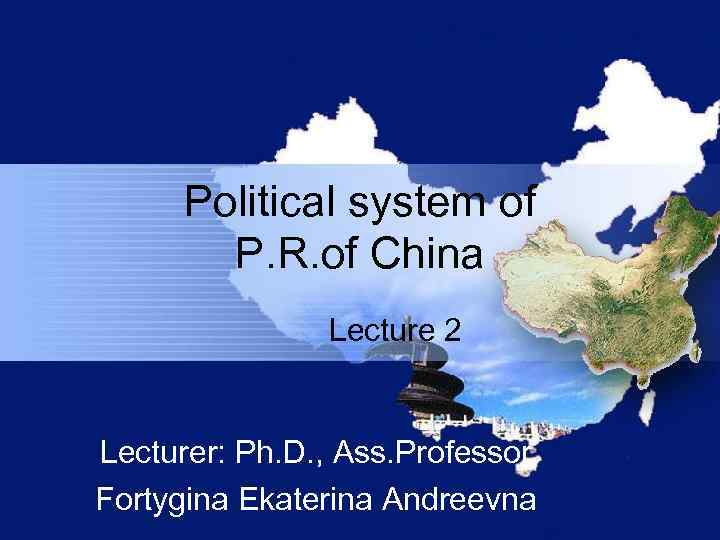 Political system of P. R. of China Lecture 2 Lecturer: Ph. D. , Ass. Professor Fortygina Ekaterina Andreevna
Political system of P. R. of China Lecture 2 Lecturer: Ph. D. , Ass. Professor Fortygina Ekaterina Andreevna
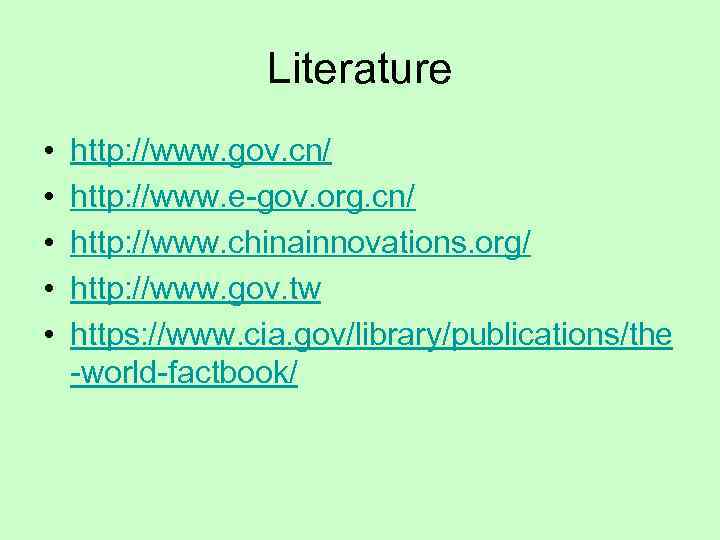 Literature • • • http: //www. gov. cn/ http: //www. e-gov. org. cn/ http: //www. chinainnovations. org/ http: //www. gov. tw https: //www. cia. gov/library/publications/the -world-factbook/
Literature • • • http: //www. gov. cn/ http: //www. e-gov. org. cn/ http: //www. chinainnovations. org/ http: //www. gov. tw https: //www. cia. gov/library/publications/the -world-factbook/
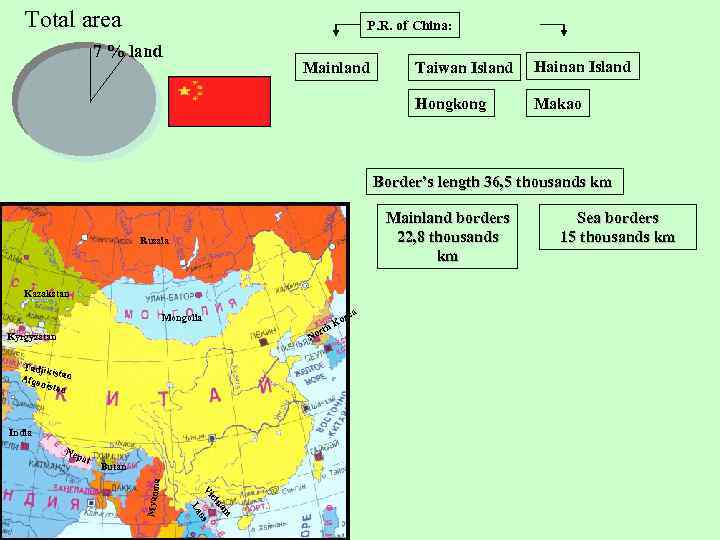 Total area P. R. of China: 7 % land Taiwan Island Hainan Island Hongkong Mainland Makao Border’s length 36, 5 thousands km Mainland borders 22, 8 thousands km Russia Kazakstan a ore h. K rt Mongolia No Kyrgyzstan Tadjik istan Afga nista n India Nep a Butan m na et os La Vi Myanm al Sea borders 15 thousands km
Total area P. R. of China: 7 % land Taiwan Island Hainan Island Hongkong Mainland Makao Border’s length 36, 5 thousands km Mainland borders 22, 8 thousands km Russia Kazakstan a ore h. K rt Mongolia No Kyrgyzstan Tadjik istan Afga nista n India Nep a Butan m na et os La Vi Myanm al Sea borders 15 thousands km
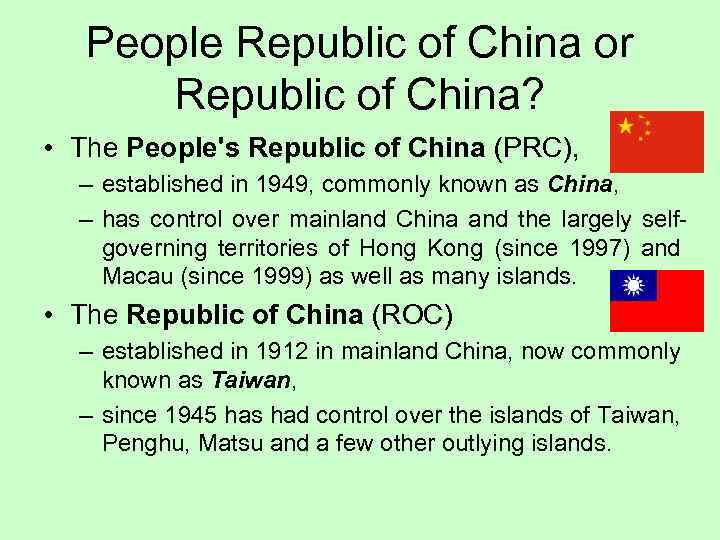 People Republic of China or Republic of China? • The People's Republic of China (PRC), – established in 1949, commonly known as China, – has control over mainland China and the largely selfgoverning territories of Hong Kong (since 1997) and Macau (since 1999) as well as many islands. • The Republic of China (ROC) – established in 1912 in mainland China, now commonly known as Taiwan, – since 1945 has had control over the islands of Taiwan, Penghu, Matsu and a few other outlying islands.
People Republic of China or Republic of China? • The People's Republic of China (PRC), – established in 1949, commonly known as China, – has control over mainland China and the largely selfgoverning territories of Hong Kong (since 1997) and Macau (since 1999) as well as many islands. • The Republic of China (ROC) – established in 1912 in mainland China, now commonly known as Taiwan, – since 1945 has had control over the islands of Taiwan, Penghu, Matsu and a few other outlying islands.
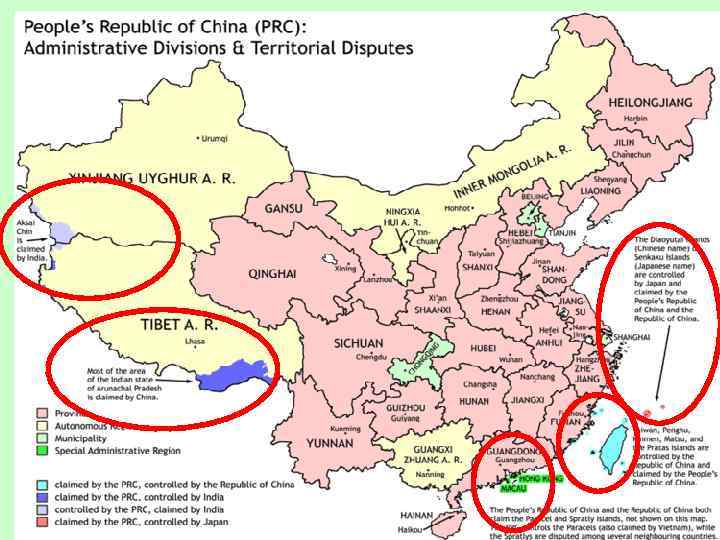
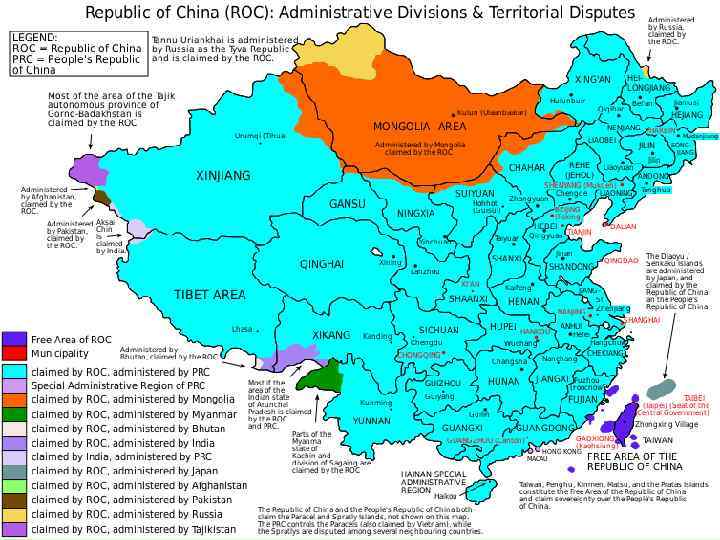
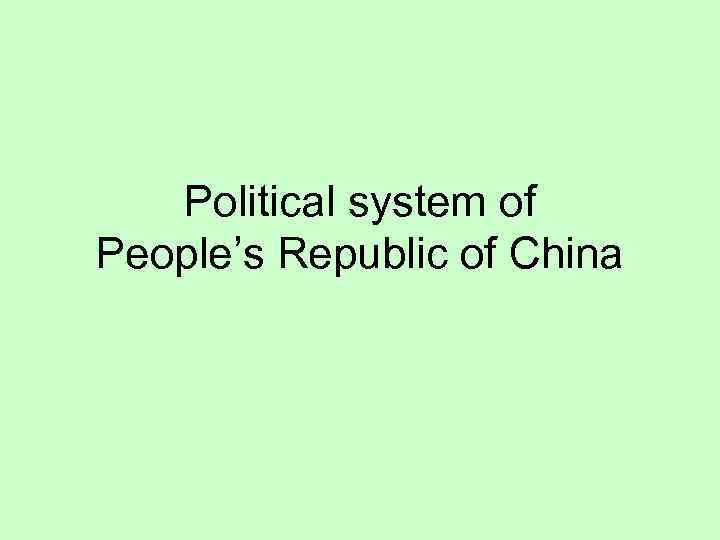 Political system of People’s Republic of China
Political system of People’s Republic of China
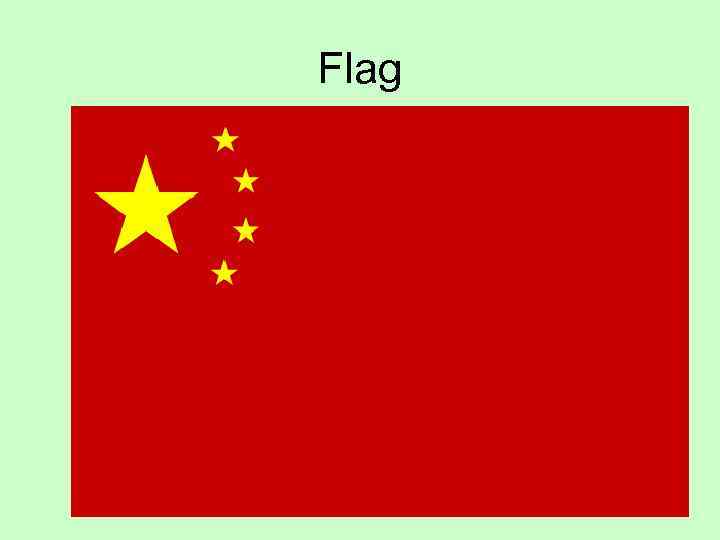 Flag
Flag
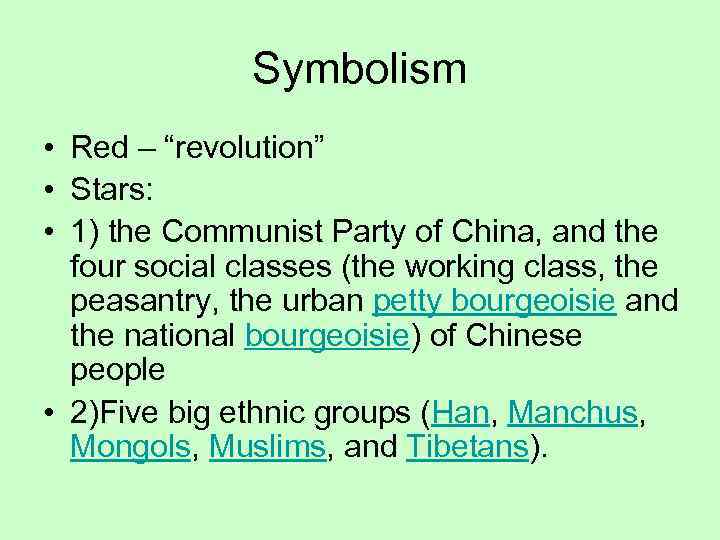 Symbolism • Red – “revolution” • Stars: • 1) the Communist Party of China, and the four social classes (the working class, the peasantry, the urban petty bourgeoisie and the national bourgeoisie) of Chinese people • 2)Five big ethnic groups (Han, Manchus, Mongols, Muslims, and Tibetans).
Symbolism • Red – “revolution” • Stars: • 1) the Communist Party of China, and the four social classes (the working class, the peasantry, the urban petty bourgeoisie and the national bourgeoisie) of Chinese people • 2)Five big ethnic groups (Han, Manchus, Mongols, Muslims, and Tibetans).
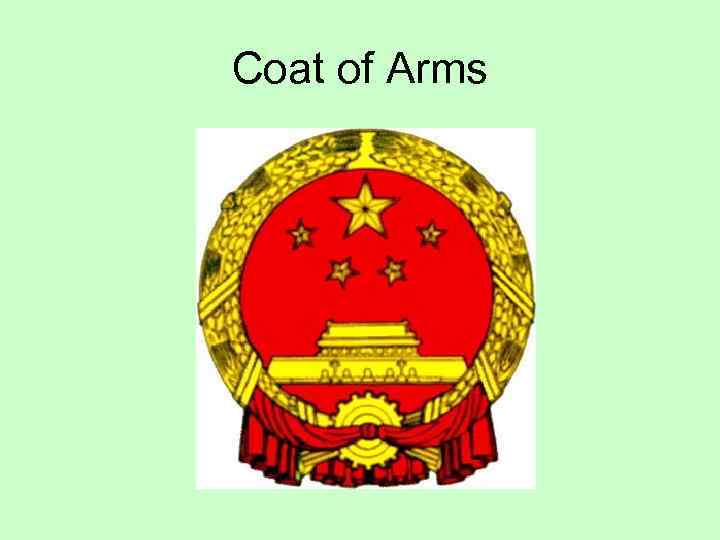 Coat of Arms
Coat of Arms
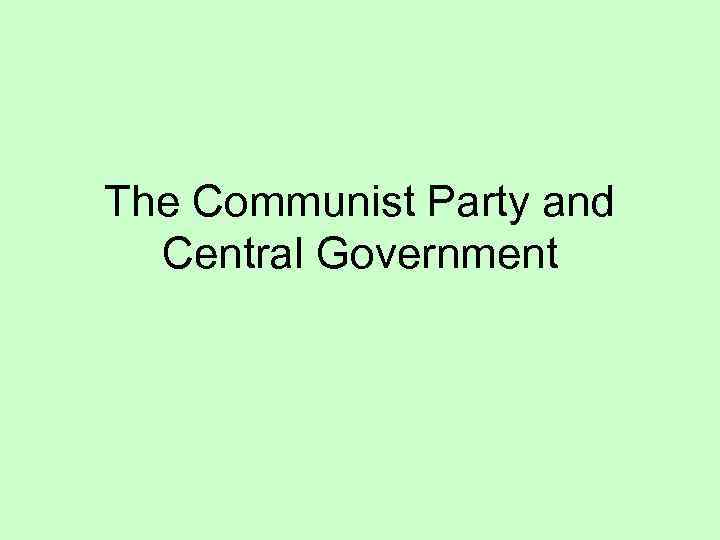 The Communist Party and Central Government
The Communist Party and Central Government
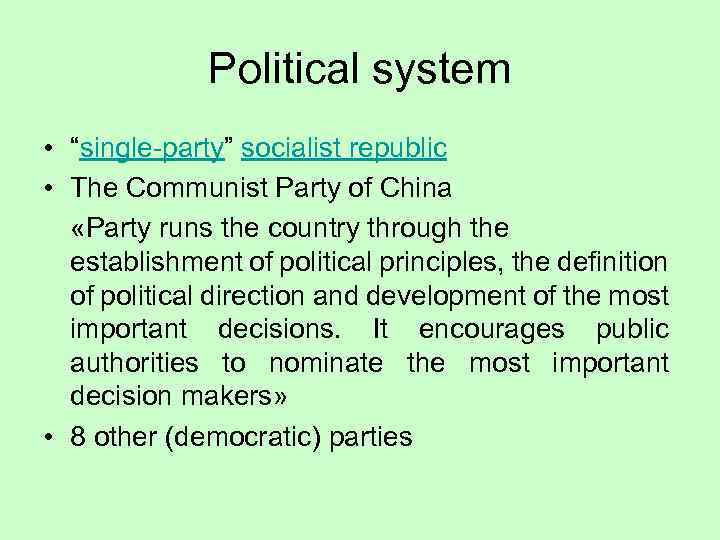 Political system • “single-party” socialist republic • The Communist Party of China «Party runs the country through the establishment of political principles, the definition of political direction and development of the most important decisions. It encourages public authorities to nominate the most important decision makers» • 8 other (democratic) parties
Political system • “single-party” socialist republic • The Communist Party of China «Party runs the country through the establishment of political principles, the definition of political direction and development of the most important decisions. It encourages public authorities to nominate the most important decision makers» • 8 other (democratic) parties
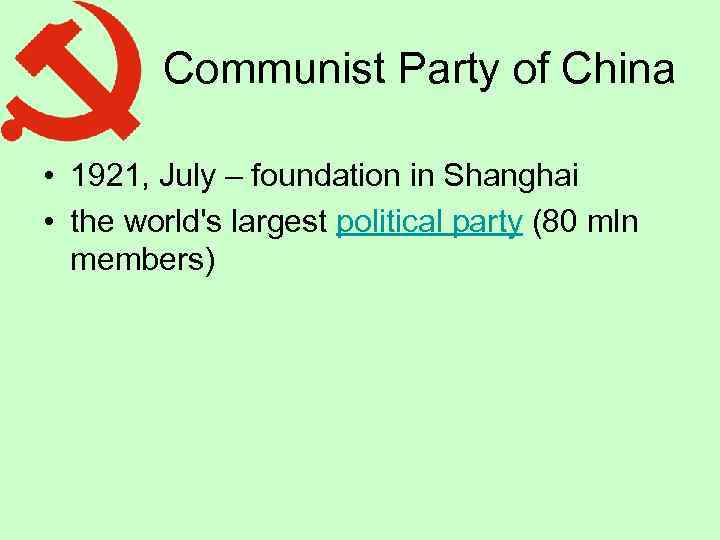 Communist Party of China • 1921, July – foundation in Shanghai • the world's largest political party (80 mln members)
Communist Party of China • 1921, July – foundation in Shanghai • the world's largest political party (80 mln members)
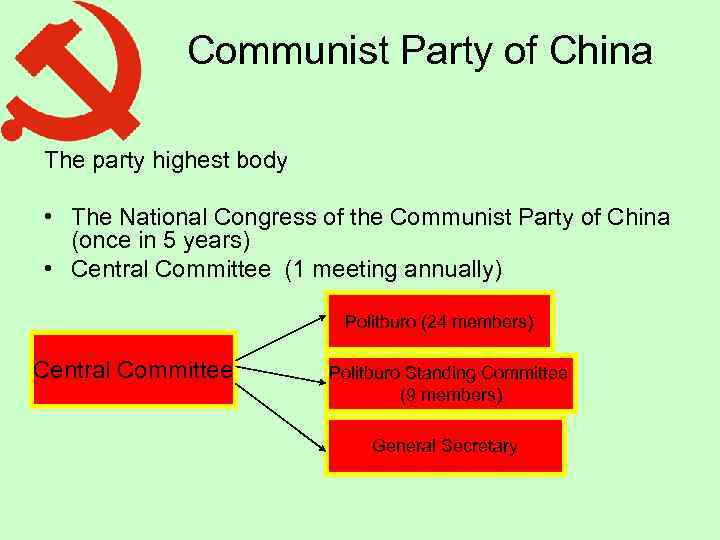 Communist Party of China The party highest body • The National Congress of the Communist Party of China (once in 5 years) • Central Committee (1 meeting annually) Politburo (24 members) Central Committee Politburo Standing Committee (9 members) General Secretary
Communist Party of China The party highest body • The National Congress of the Communist Party of China (once in 5 years) • Central Committee (1 meeting annually) Politburo (24 members) Central Committee Politburo Standing Committee (9 members) General Secretary
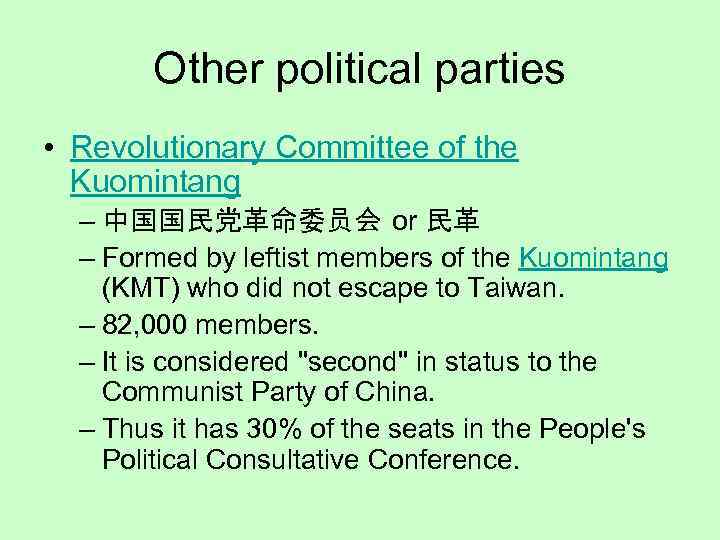 Other political parties • Revolutionary Committee of the Kuomintang – 中国国民党革命委员会 or 民革 – Formed by leftist members of the Kuomintang (KMT) who did not escape to Taiwan. – 82, 000 members. – It is considered "second" in status to the Communist Party of China. – Thus it has 30% of the seats in the People's Political Consultative Conference.
Other political parties • Revolutionary Committee of the Kuomintang – 中国国民党革命委员会 or 民革 – Formed by leftist members of the Kuomintang (KMT) who did not escape to Taiwan. – 82, 000 members. – It is considered "second" in status to the Communist Party of China. – Thus it has 30% of the seats in the People's Political Consultative Conference.
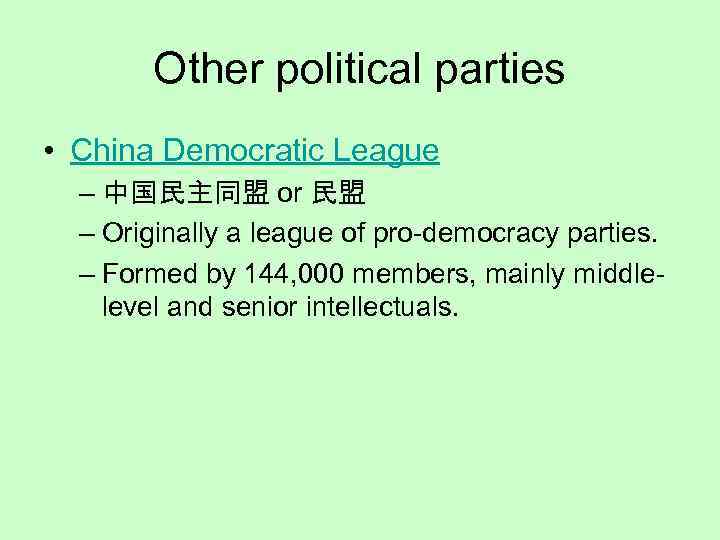 Other political parties • China Democratic League – 中国民主同盟 or 民盟 – Originally a league of pro-democracy parties. – Formed by 144, 000 members, mainly middlelevel and senior intellectuals.
Other political parties • China Democratic League – 中国民主同盟 or 民盟 – Originally a league of pro-democracy parties. – Formed by 144, 000 members, mainly middlelevel and senior intellectuals.
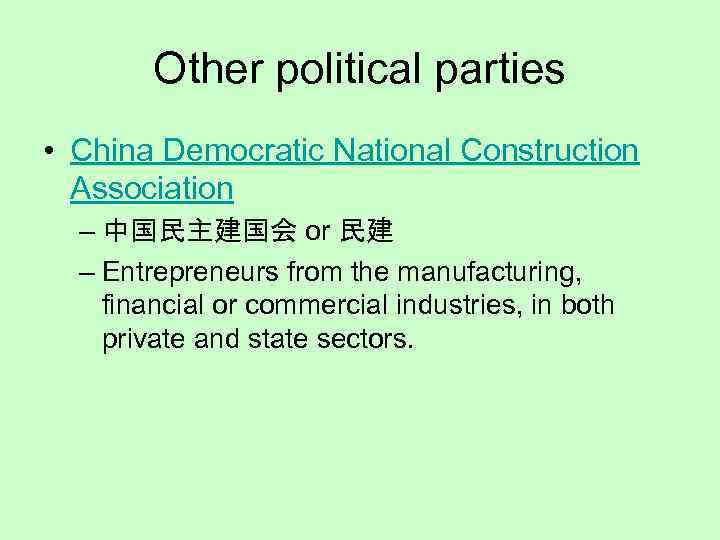 Other political parties • China Democratic National Construction Association – 中国民主建国会 or 民建 – Entrepreneurs from the manufacturing, financial or commercial industries, in both private and state sectors.
Other political parties • China Democratic National Construction Association – 中国民主建国会 or 民建 – Entrepreneurs from the manufacturing, financial or commercial industries, in both private and state sectors.
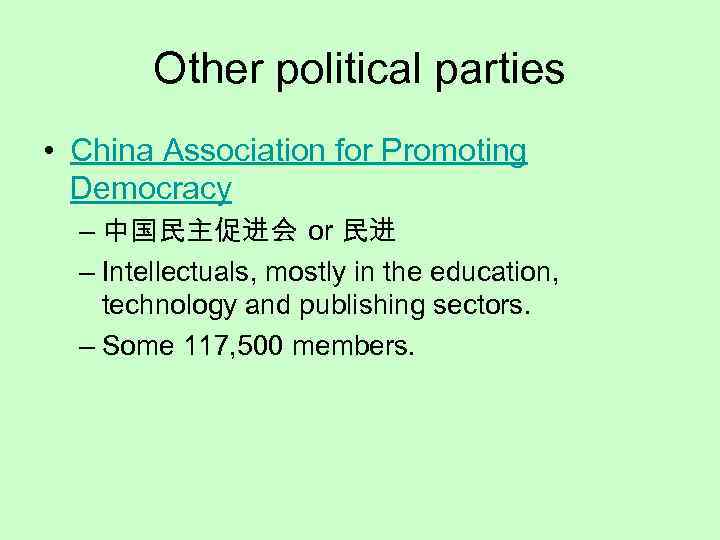 Other political parties • China Association for Promoting Democracy – 中国民主促进会 or 民进 – Intellectuals, mostly in the education, technology and publishing sectors. – Some 117, 500 members.
Other political parties • China Association for Promoting Democracy – 中国民主促进会 or 民进 – Intellectuals, mostly in the education, technology and publishing sectors. – Some 117, 500 members.
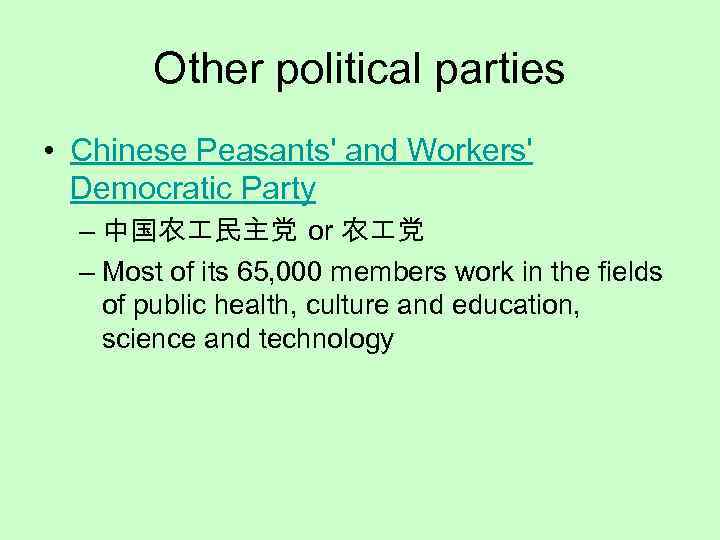 Other political parties • Chinese Peasants' and Workers' Democratic Party – 中国农 民主党 or 农 党 – Most of its 65, 000 members work in the fields of public health, culture and education, science and technology
Other political parties • Chinese Peasants' and Workers' Democratic Party – 中国农 民主党 or 农 党 – Most of its 65, 000 members work in the fields of public health, culture and education, science and technology
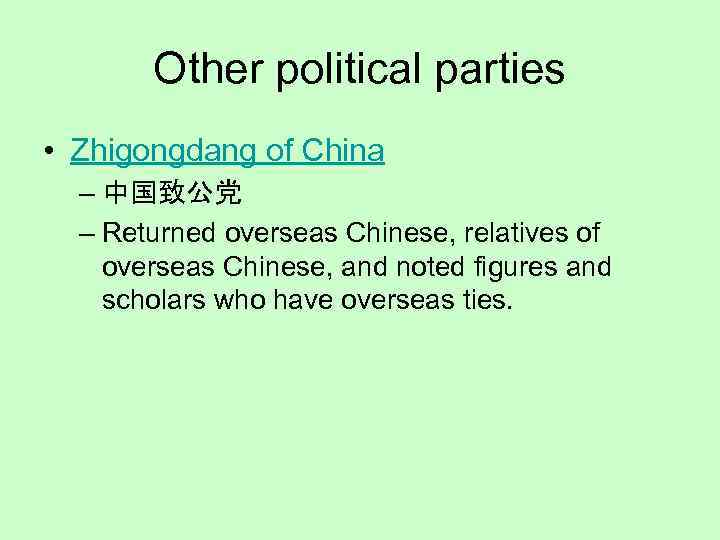 Other political parties • Zhigongdang of China – 中国致公党 – Returned overseas Chinese, relatives of overseas Chinese, and noted figures and scholars who have overseas ties.
Other political parties • Zhigongdang of China – 中国致公党 – Returned overseas Chinese, relatives of overseas Chinese, and noted figures and scholars who have overseas ties.
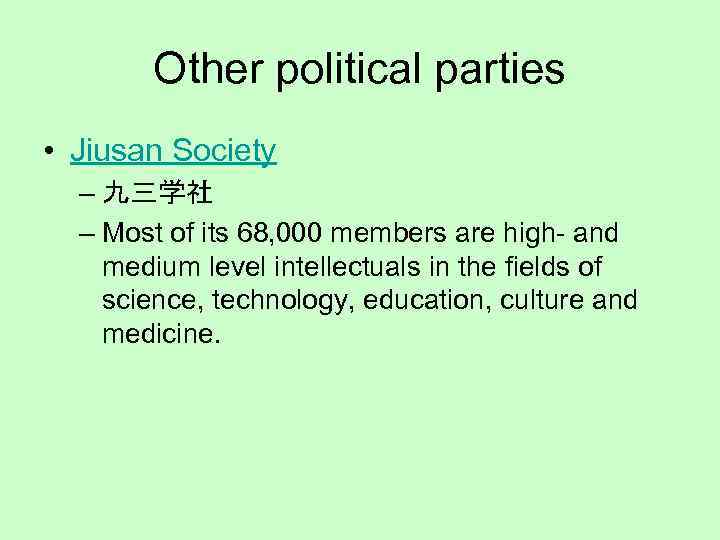 Other political parties • Jiusan Society – 九三学社 – Most of its 68, 000 members are high- and medium level intellectuals in the fields of science, technology, education, culture and medicine.
Other political parties • Jiusan Society – 九三学社 – Most of its 68, 000 members are high- and medium level intellectuals in the fields of science, technology, education, culture and medicine.
 Other political parties • Taiwan Democratic Self-Government League – 台湾民主自治同盟 or 台盟 – 1, 600 people, most of whom are prominent people that are from Taiwan or are of Taiwanese heritage, but now reside on the Mainland.
Other political parties • Taiwan Democratic Self-Government League – 台湾民主自治同盟 or 台盟 – 1, 600 people, most of whom are prominent people that are from Taiwan or are of Taiwanese heritage, but now reside on the Mainland.
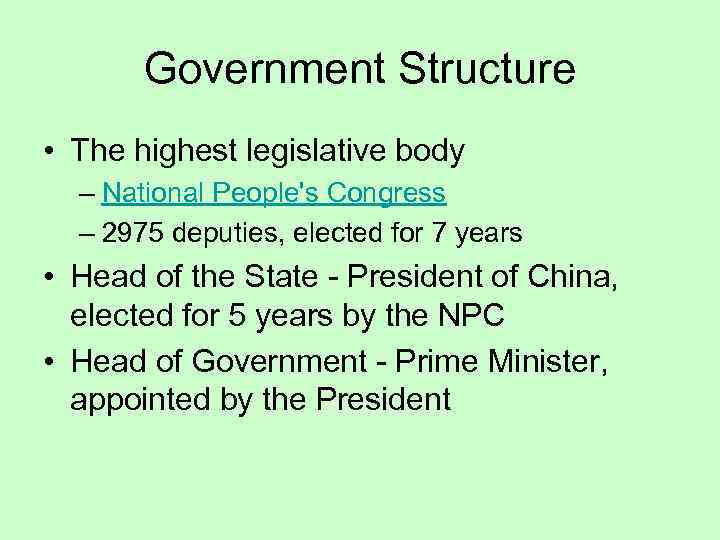 Government Structure • The highest legislative body – National People's Congress – 2975 deputies, elected for 7 years • Head of the State - President of China, elected for 5 years by the NPC • Head of Government - Prime Minister, appointed by the President
Government Structure • The highest legislative body – National People's Congress – 2975 deputies, elected for 7 years • Head of the State - President of China, elected for 5 years by the NPC • Head of Government - Prime Minister, appointed by the President
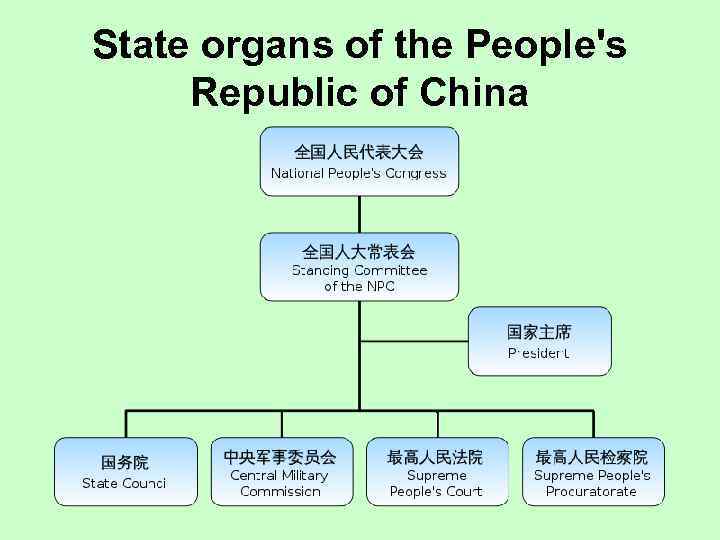 State organs of the People's Republic of China
State organs of the People's Republic of China
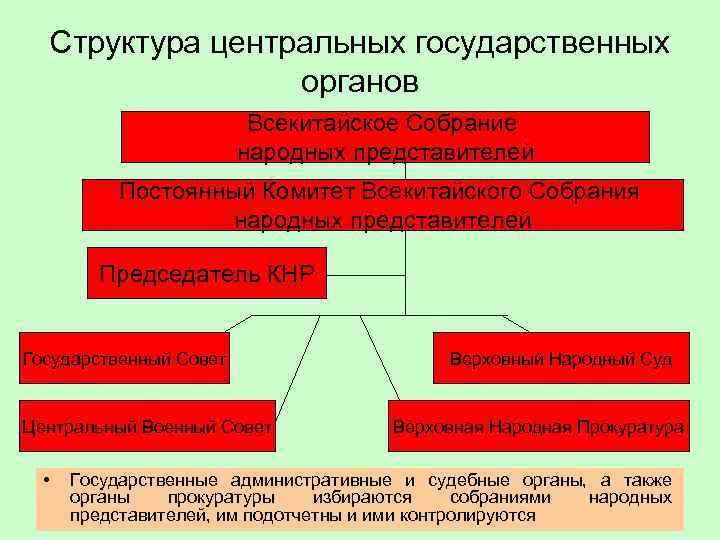 Структура центральных государственных органов Всекитайское Собрание народных представителей Постоянный Комитет Всекитайского Собрания народных представителей Председатель КНР Государственный Совет Центральный Военный Совет • Верховный Народный Суд Верховная Народная Прокуратура Государственные административные и судебные органы, а также органы прокуратуры избираются собраниями народных представителей, им подотчетны и ими контролируются
Структура центральных государственных органов Всекитайское Собрание народных представителей Постоянный Комитет Всекитайского Собрания народных представителей Председатель КНР Государственный Совет Центральный Военный Совет • Верховный Народный Суд Верховная Народная Прокуратура Государственные административные и судебные органы, а также органы прокуратуры избираются собраниями народных представителей, им подотчетны и ими контролируются
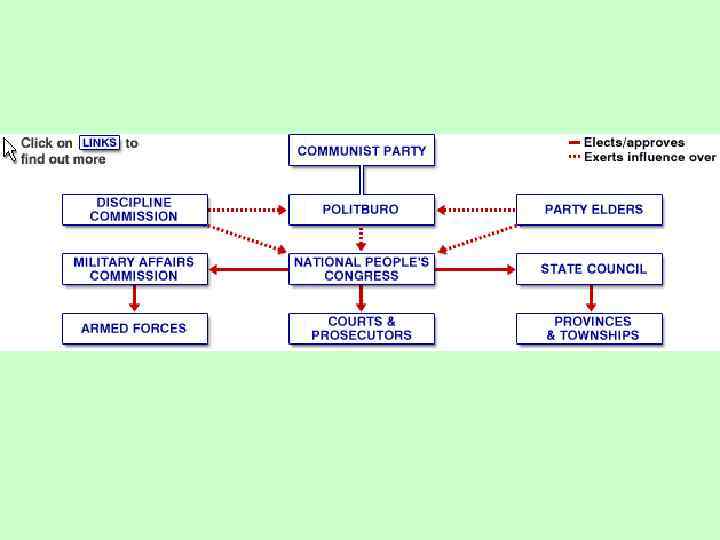
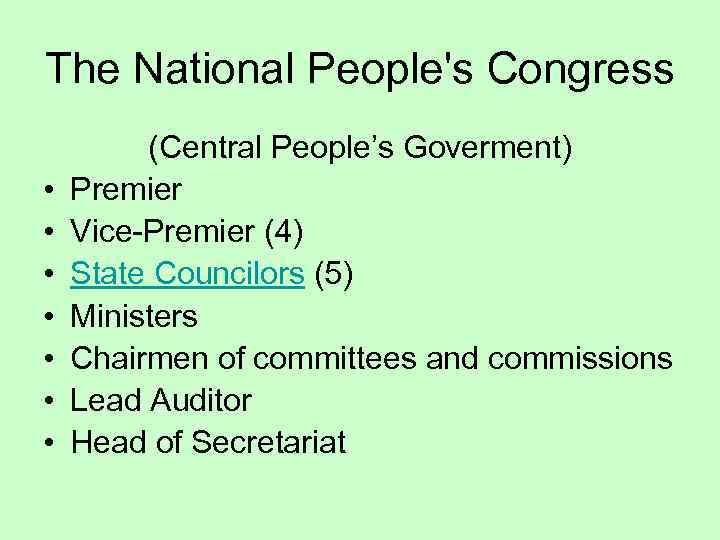 The National People's Congress • • (Central People’s Goverment) Premier Vice-Premier (4) State Councilors (5) Ministers Chairmen of committees and commissions Lead Auditor Head of Secretariat
The National People's Congress • • (Central People’s Goverment) Premier Vice-Premier (4) State Councilors (5) Ministers Chairmen of committees and commissions Lead Auditor Head of Secretariat
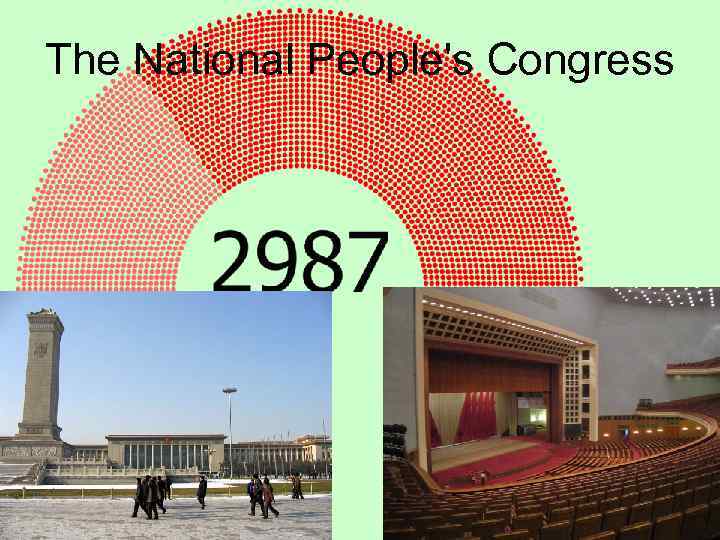 The National People's Congress
The National People's Congress
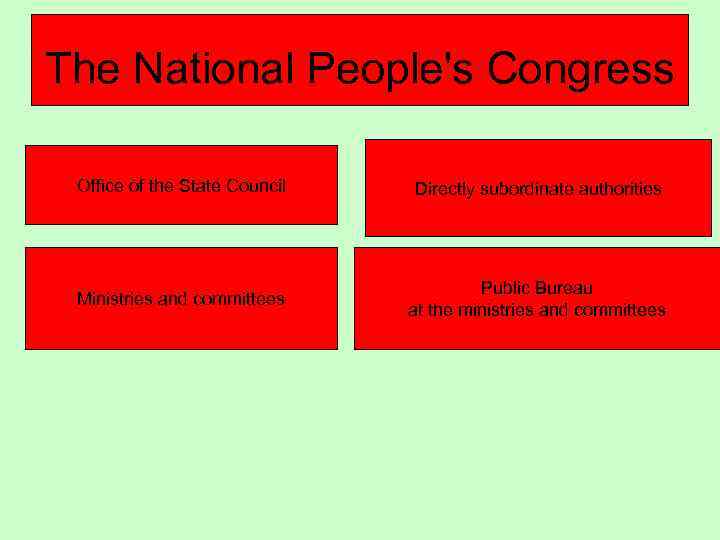 The National People's Congress Office of the State Council Directly subordinate authorities Ministries and committees Public Bureau at the ministries and committees
The National People's Congress Office of the State Council Directly subordinate authorities Ministries and committees Public Bureau at the ministries and committees
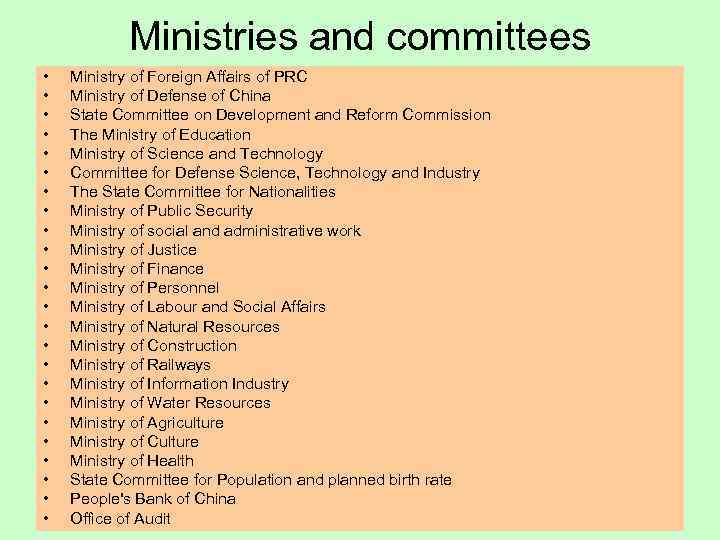 Ministries and committees • • • • • • Ministry of Foreign Affairs of PRC Ministry of Defense of China State Committee on Development and Reform Commission The Ministry of Education Ministry of Science and Technology Committee for Defense Science, Technology and Industry The State Committee for Nationalities Ministry of Public Security Ministry of social and administrative work Ministry of Justice Ministry of Finance Ministry of Personnel Ministry of Labour and Social Affairs Ministry of Natural Resources Ministry of Construction Ministry of Railways Ministry of Information Industry Ministry of Water Resources Ministry of Agriculture Ministry of Culture Ministry of Health State Committee for Population and planned birth rate People's Bank of China Office of Audit
Ministries and committees • • • • • • Ministry of Foreign Affairs of PRC Ministry of Defense of China State Committee on Development and Reform Commission The Ministry of Education Ministry of Science and Technology Committee for Defense Science, Technology and Industry The State Committee for Nationalities Ministry of Public Security Ministry of social and administrative work Ministry of Justice Ministry of Finance Ministry of Personnel Ministry of Labour and Social Affairs Ministry of Natural Resources Ministry of Construction Ministry of Railways Ministry of Information Industry Ministry of Water Resources Ministry of Agriculture Ministry of Culture Ministry of Health State Committee for Population and planned birth rate People's Bank of China Office of Audit
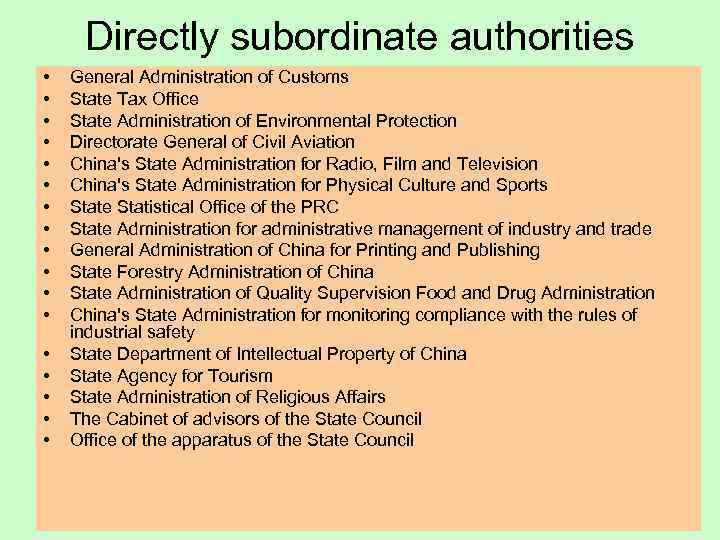 Directly subordinate authorities • • • • • General Administration of Customs State Tax Office State Administration of Environmental Protection Directorate General of Civil Aviation China's State Administration for Radio, Film and Television China's State Administration for Physical Culture and Sports State Statistical Office of the PRC State Administration for administrative management of industry and trade General Administration of China for Printing and Publishing State Forestry Administration of China State Administration of Quality Supervision Food and Drug Administration China's State Administration for monitoring compliance with the rules of industrial safety State Department of Intellectual Property of China State Agency for Tourism State Administration of Religious Affairs The Cabinet of advisors of the State Council Office of the apparatus of the State Council
Directly subordinate authorities • • • • • General Administration of Customs State Tax Office State Administration of Environmental Protection Directorate General of Civil Aviation China's State Administration for Radio, Film and Television China's State Administration for Physical Culture and Sports State Statistical Office of the PRC State Administration for administrative management of industry and trade General Administration of China for Printing and Publishing State Forestry Administration of China State Administration of Quality Supervision Food and Drug Administration China's State Administration for monitoring compliance with the rules of industrial safety State Department of Intellectual Property of China State Agency for Tourism State Administration of Religious Affairs The Cabinet of advisors of the State Council Office of the apparatus of the State Council
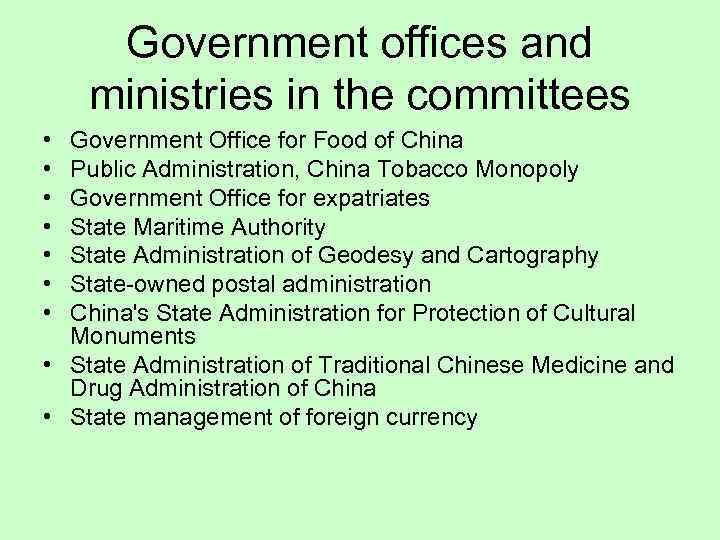 Government offices and ministries in the committees • • Government Office for Food of China Public Administration, China Tobacco Monopoly Government Office for expatriates State Maritime Authority State Administration of Geodesy and Cartography State-owned postal administration China's State Administration for Protection of Cultural Monuments • State Administration of Traditional Chinese Medicine and Drug Administration of China • State management of foreign currency
Government offices and ministries in the committees • • Government Office for Food of China Public Administration, China Tobacco Monopoly Government Office for expatriates State Maritime Authority State Administration of Geodesy and Cartography State-owned postal administration China's State Administration for Protection of Cultural Monuments • State Administration of Traditional Chinese Medicine and Drug Administration of China • State management of foreign currency
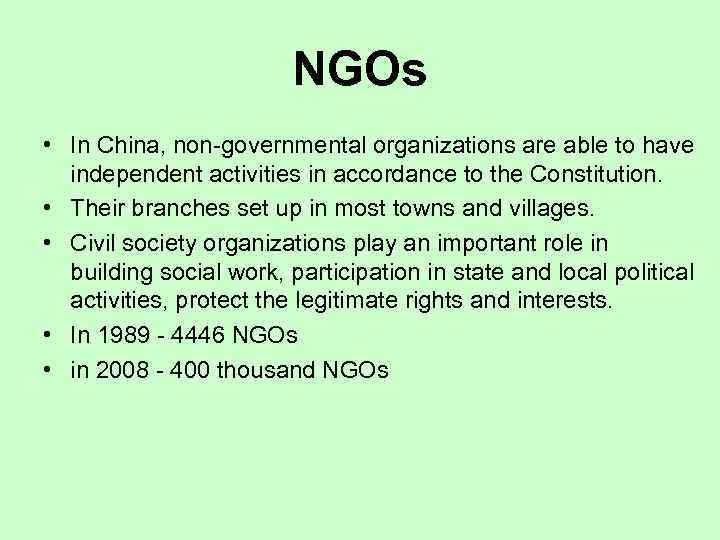 NGOs • In China, non-governmental organizations are able to have independent activities in accordance to the Constitution. • Their branches set up in most towns and villages. • Civil society organizations play an important role in building social work, participation in state and local political activities, protect the legitimate rights and interests. • In 1989 - 4446 NGOs • in 2008 - 400 thousand NGOs
NGOs • In China, non-governmental organizations are able to have independent activities in accordance to the Constitution. • Their branches set up in most towns and villages. • Civil society organizations play an important role in building social work, participation in state and local political activities, protect the legitimate rights and interests. • In 1989 - 4446 NGOs • in 2008 - 400 thousand NGOs
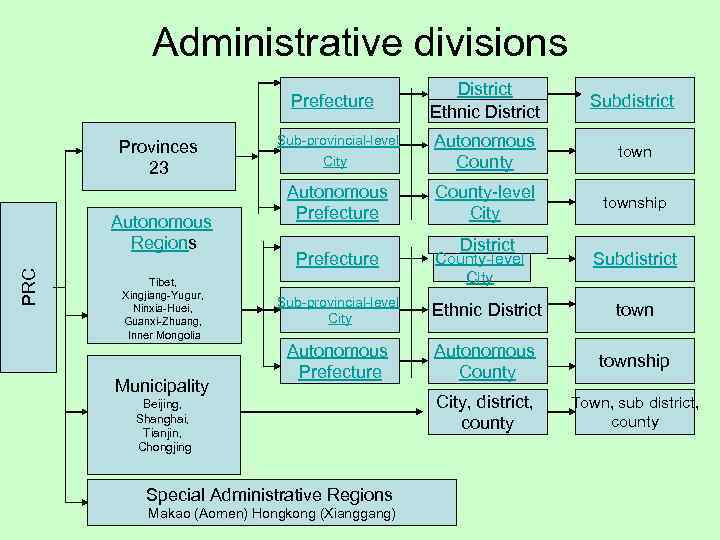 Administrative divisions District Ethnic District Subdistrict Sub-provincial-level City Autonomous County town Autonomous Prefecture County-level City township Prefecture Provinces 23 PRC Autonomous Regions Tibet, Xingjiang-Yugur, Ninxia-Huei, Guanxi-Zhuang, Inner Mongolia Municipality Prefecture District County-level City Subdistrict Sub-provincial-level City Ethnic District town Autonomous Prefecture Autonomous County township City, district, county Town, sub district, county Beijing, Shanghai, Tianjin, Chongjing Special Administrative Regions Makao (Aomen) Hongkong (Xianggang)
Administrative divisions District Ethnic District Subdistrict Sub-provincial-level City Autonomous County town Autonomous Prefecture County-level City township Prefecture Provinces 23 PRC Autonomous Regions Tibet, Xingjiang-Yugur, Ninxia-Huei, Guanxi-Zhuang, Inner Mongolia Municipality Prefecture District County-level City Subdistrict Sub-provincial-level City Ethnic District town Autonomous Prefecture Autonomous County township City, district, county Town, sub district, county Beijing, Shanghai, Tianjin, Chongjing Special Administrative Regions Makao (Aomen) Hongkong (Xianggang)
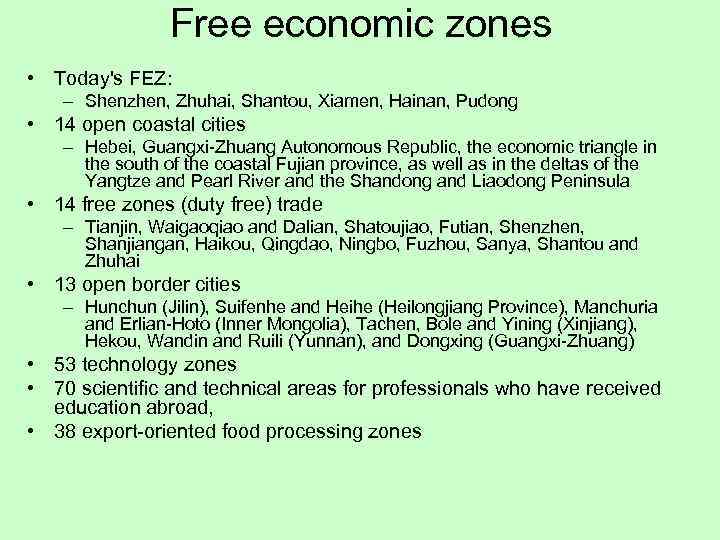 Free economic zones • Today's FEZ: – Shenzhen, Zhuhai, Shantou, Xiamen, Hainan, Pudong • 14 open coastal cities – Hebei, Guangxi-Zhuang Autonomous Republic, the economic triangle in the south of the coastal Fujian province, as well as in the deltas of the Yangtze and Pearl River and the Shandong and Liaodong Peninsula • 14 free zones (duty free) trade – Tianjin, Waigaoqiao and Dalian, Shatoujiao, Futian, Shenzhen, Shanjiangan, Haikou, Qingdao, Ningbo, Fuzhou, Sanya, Shantou and Zhuhai • 13 open border cities – Hunchun (Jilin), Suifenhe and Heihe (Heilongjiang Province), Manchuria and Erlian-Hoto (Inner Mongolia), Tachen, Bole and Yining (Xinjiang), Hekou, Wandin and Ruili (Yunnan), and Dongxing (Guangxi-Zhuang) • 53 technology zones • 70 scientific and technical areas for professionals who have received education abroad, • 38 export-oriented food processing zones
Free economic zones • Today's FEZ: – Shenzhen, Zhuhai, Shantou, Xiamen, Hainan, Pudong • 14 open coastal cities – Hebei, Guangxi-Zhuang Autonomous Republic, the economic triangle in the south of the coastal Fujian province, as well as in the deltas of the Yangtze and Pearl River and the Shandong and Liaodong Peninsula • 14 free zones (duty free) trade – Tianjin, Waigaoqiao and Dalian, Shatoujiao, Futian, Shenzhen, Shanjiangan, Haikou, Qingdao, Ningbo, Fuzhou, Sanya, Shantou and Zhuhai • 13 open border cities – Hunchun (Jilin), Suifenhe and Heihe (Heilongjiang Province), Manchuria and Erlian-Hoto (Inner Mongolia), Tachen, Bole and Yining (Xinjiang), Hekou, Wandin and Ruili (Yunnan), and Dongxing (Guangxi-Zhuang) • 53 technology zones • 70 scientific and technical areas for professionals who have received education abroad, • 38 export-oriented food processing zones
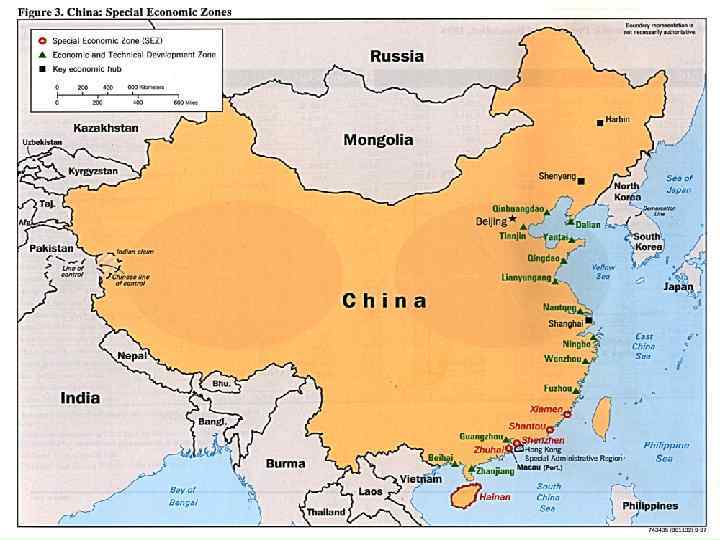
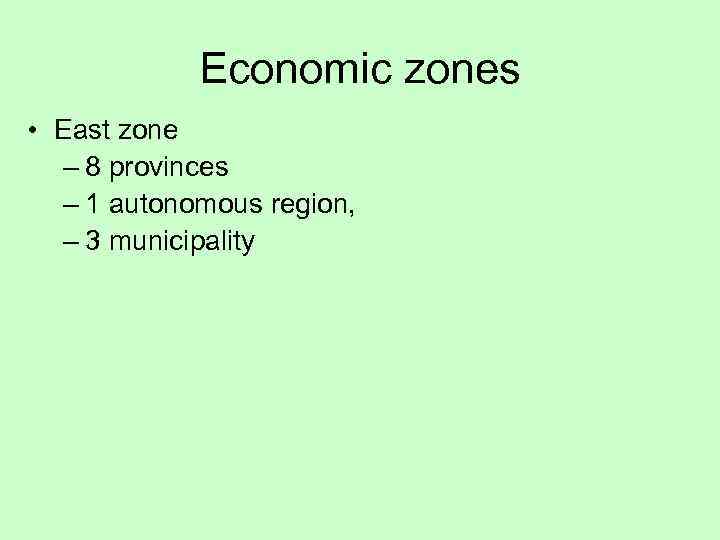 Economic zones • East zone – 8 provinces – 1 autonomous region, – 3 municipality
Economic zones • East zone – 8 provinces – 1 autonomous region, – 3 municipality
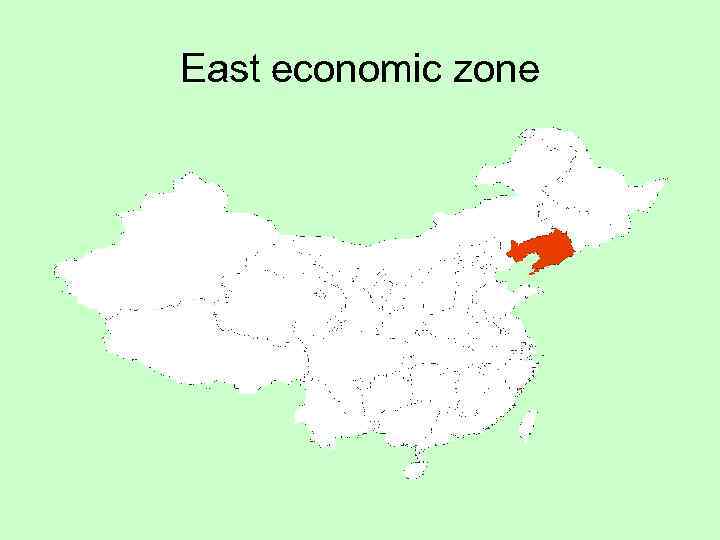 East economic zone
East economic zone
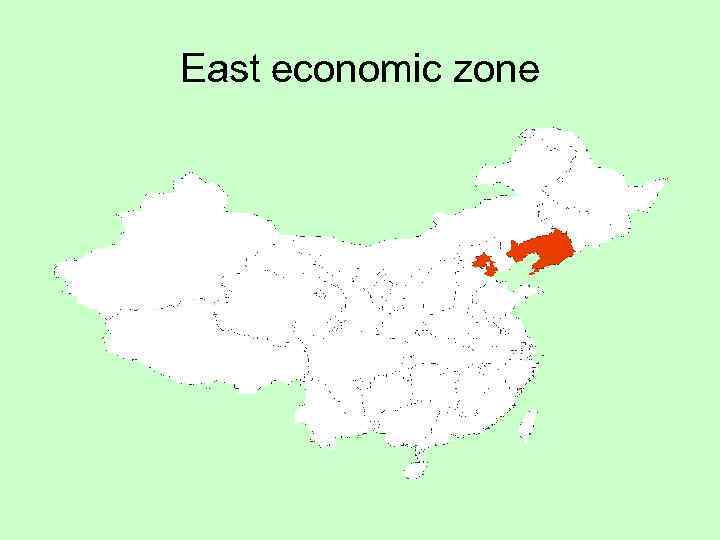 East economic zone
East economic zone
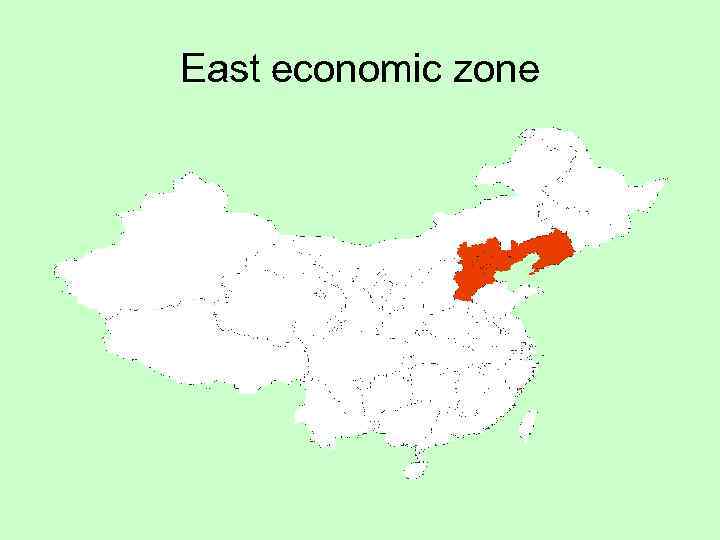 East economic zone
East economic zone
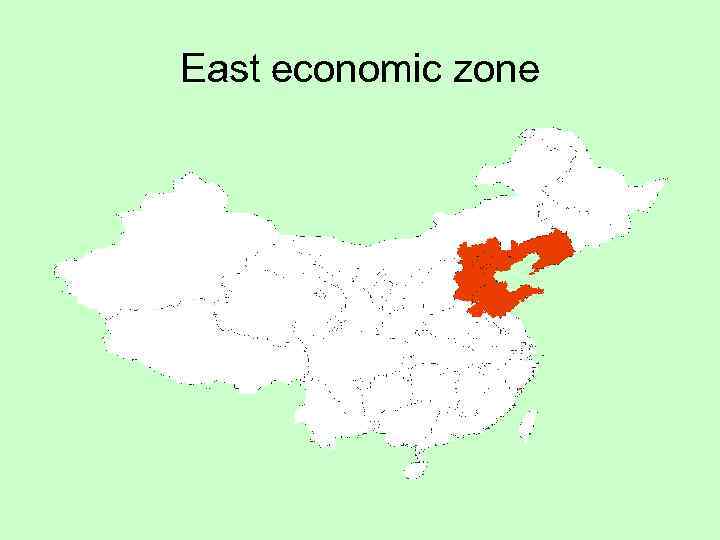 East economic zone
East economic zone
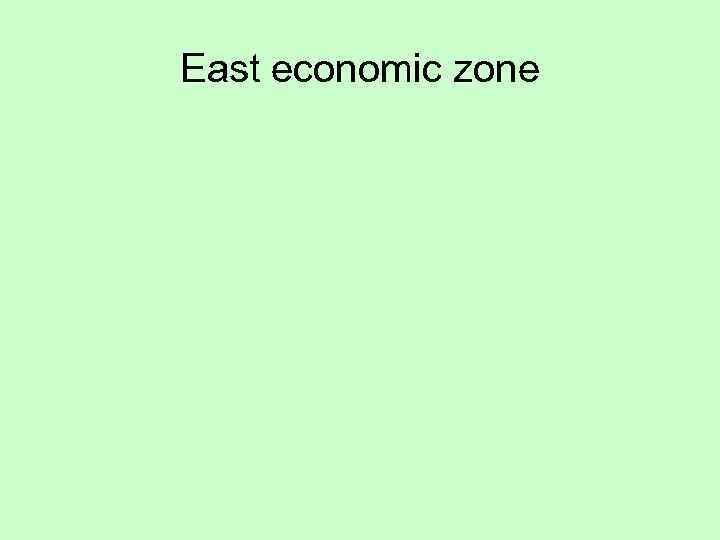 East economic zone
East economic zone
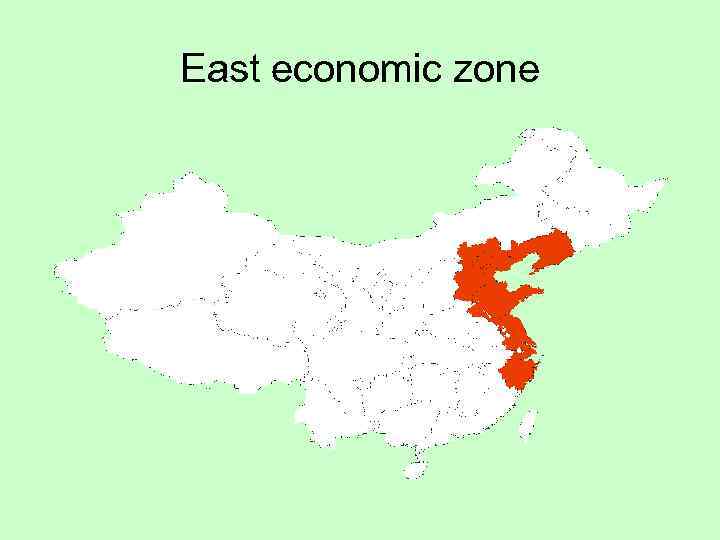 East economic zone
East economic zone
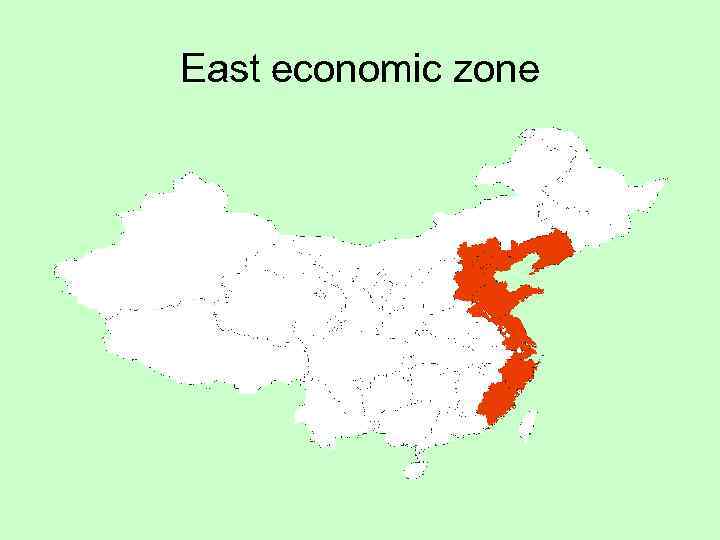 East economic zone
East economic zone
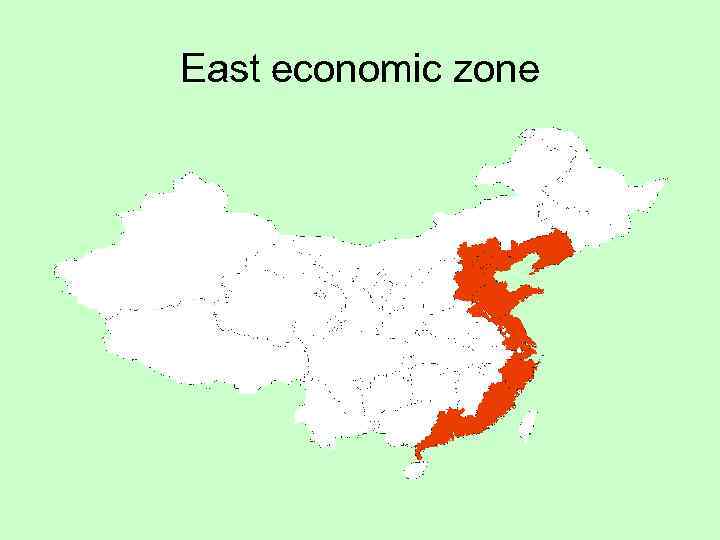 East economic zone
East economic zone
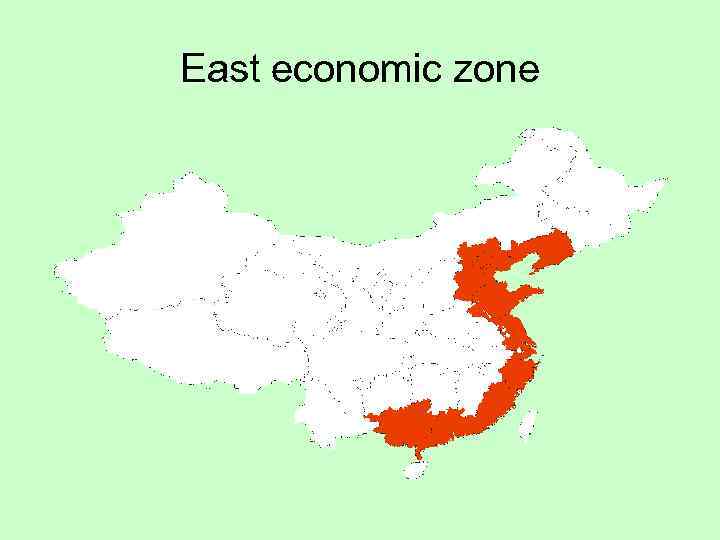 East economic zone
East economic zone
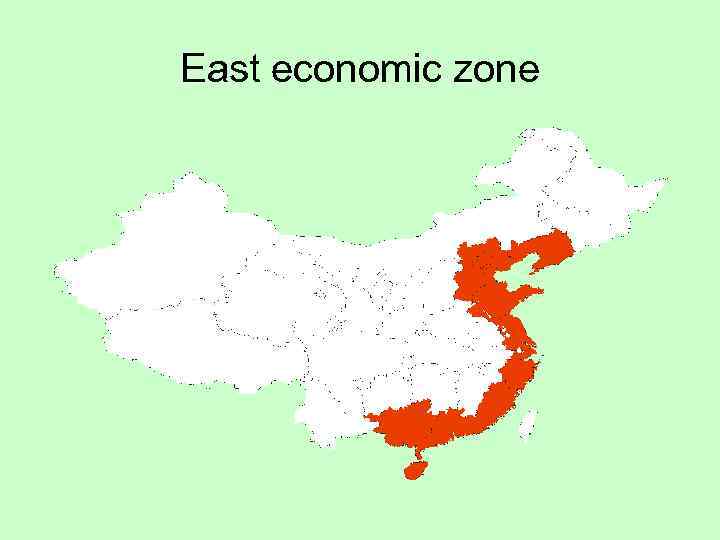 East economic zone
East economic zone
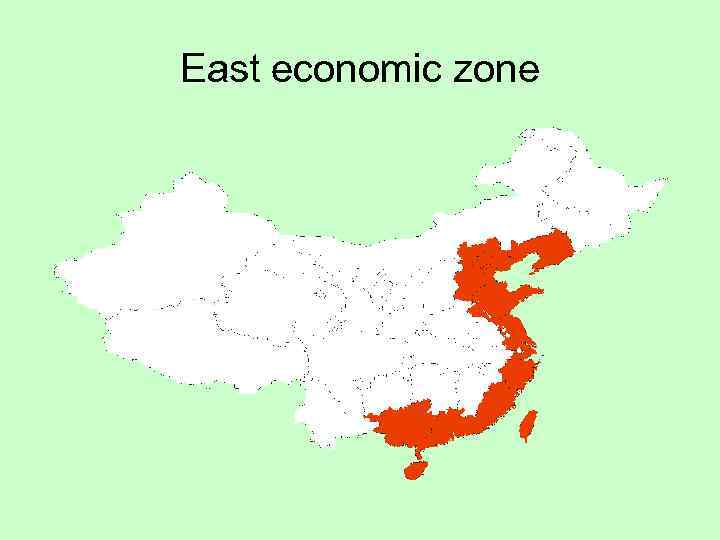 East economic zone
East economic zone
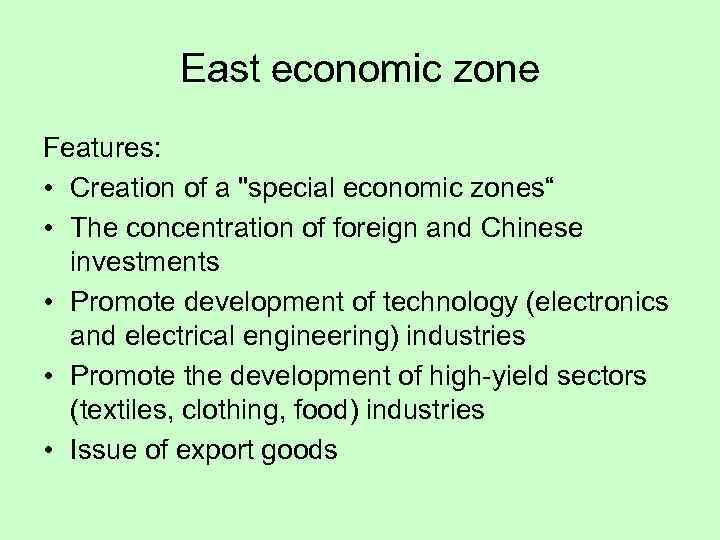 East economic zone Features: • Creation of a "special economic zones“ • The concentration of foreign and Chinese investments • Promote development of technology (electronics and electrical engineering) industries • Promote the development of high-yield sectors (textiles, clothing, food) industries • Issue of export goods
East economic zone Features: • Creation of a "special economic zones“ • The concentration of foreign and Chinese investments • Promote development of technology (electronics and electrical engineering) industries • Promote the development of high-yield sectors (textiles, clothing, food) industries • Issue of export goods
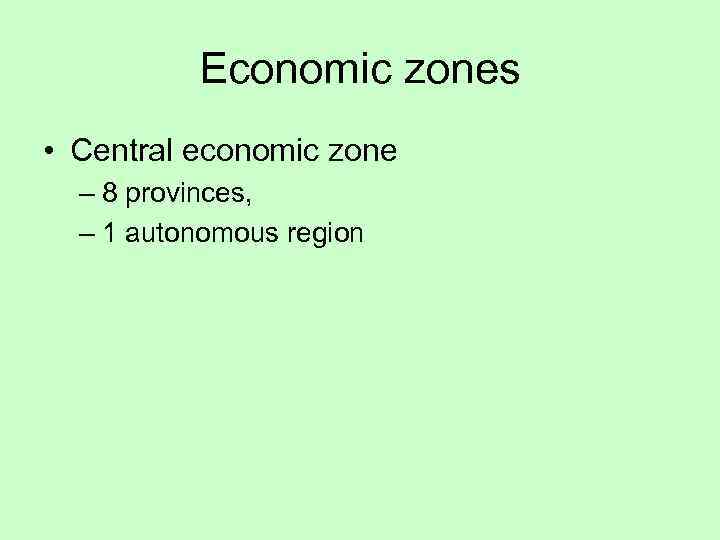 Economic zones • Central economic zone – 8 provinces, – 1 autonomous region
Economic zones • Central economic zone – 8 provinces, – 1 autonomous region
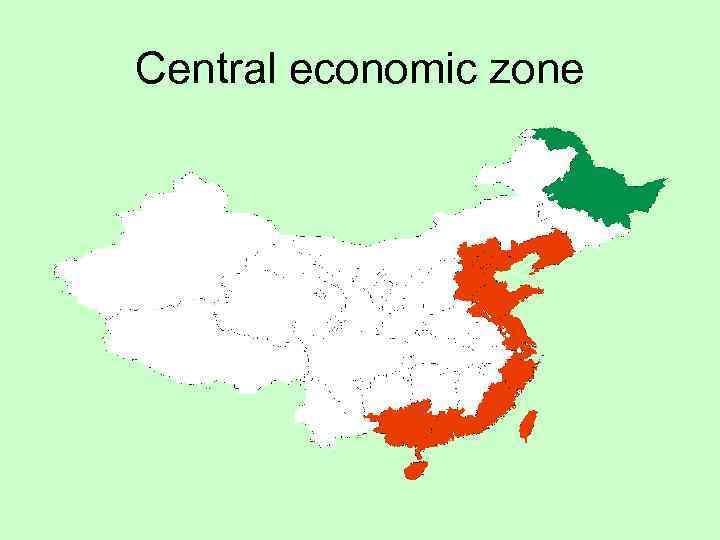 Central economic zone
Central economic zone
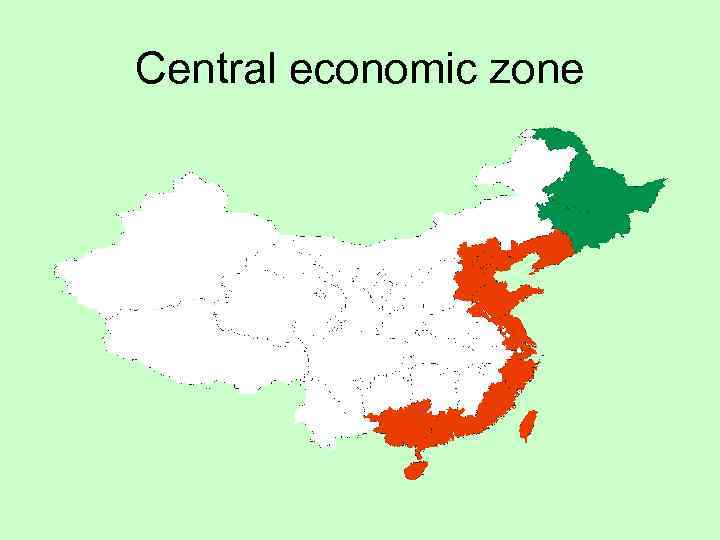 Central economic zone
Central economic zone
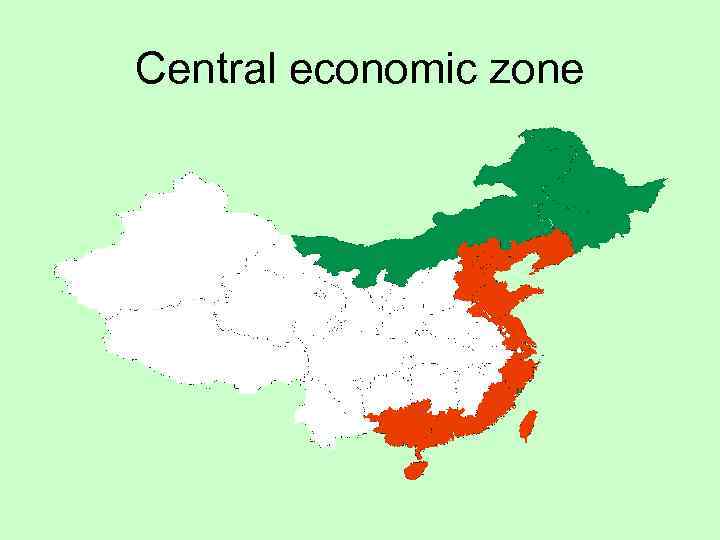 Central economic zone
Central economic zone
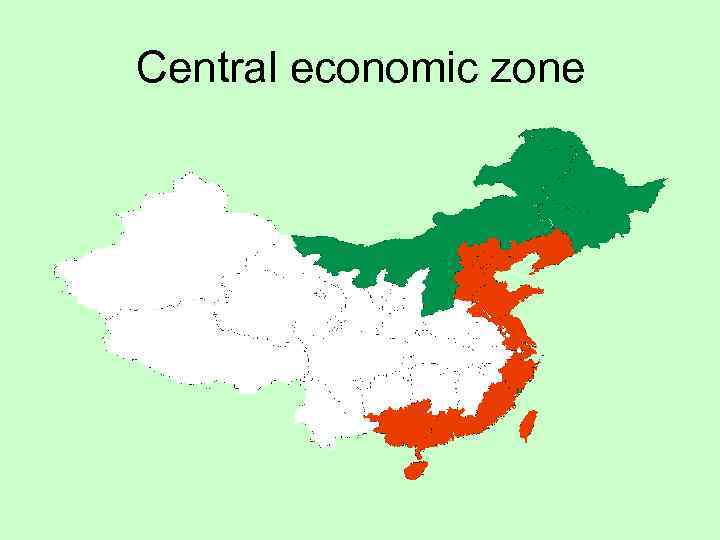 Central economic zone
Central economic zone
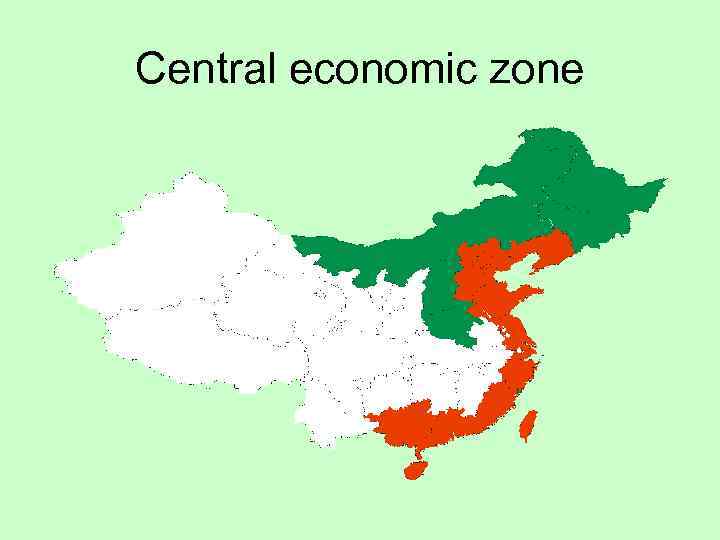 Central economic zone
Central economic zone
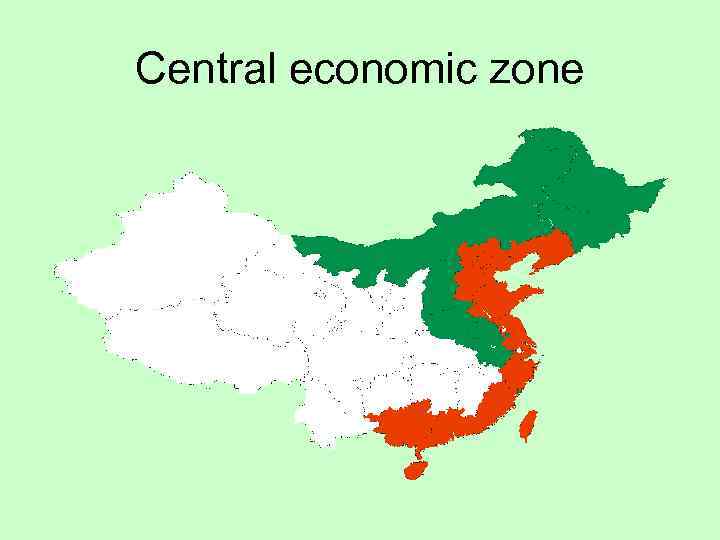 Central economic zone
Central economic zone
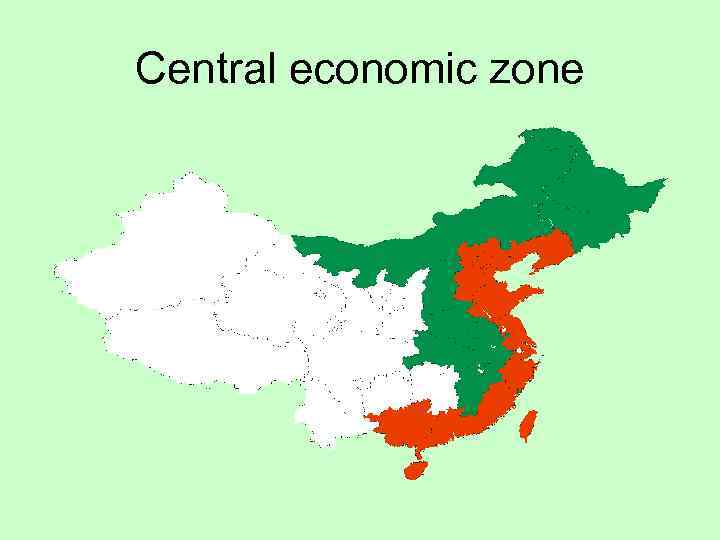 Central economic zone
Central economic zone
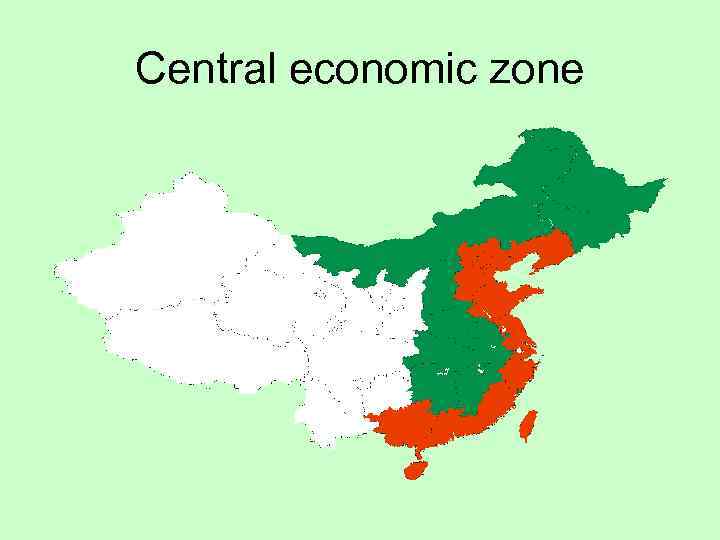 Central economic zone
Central economic zone
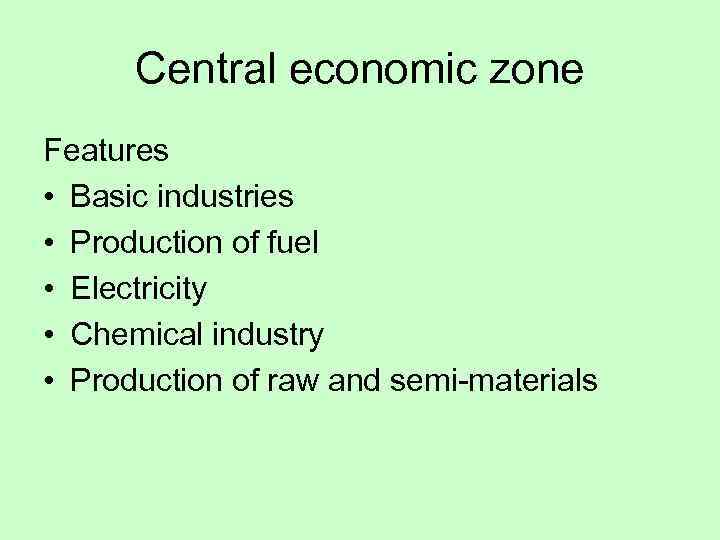 Central economic zone Features • Basic industries • Production of fuel • Electricity • Chemical industry • Production of raw and semi-materials
Central economic zone Features • Basic industries • Production of fuel • Electricity • Chemical industry • Production of raw and semi-materials
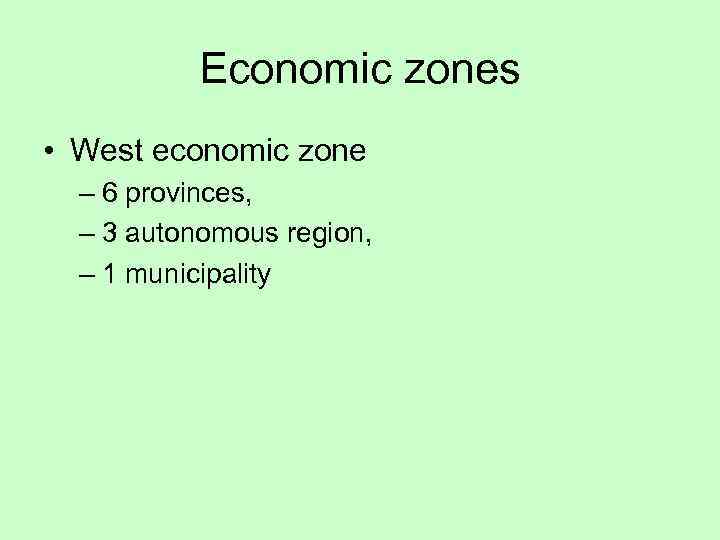 Economic zones • West economic zone – 6 provinces, – 3 autonomous region, – 1 municipality
Economic zones • West economic zone – 6 provinces, – 3 autonomous region, – 1 municipality
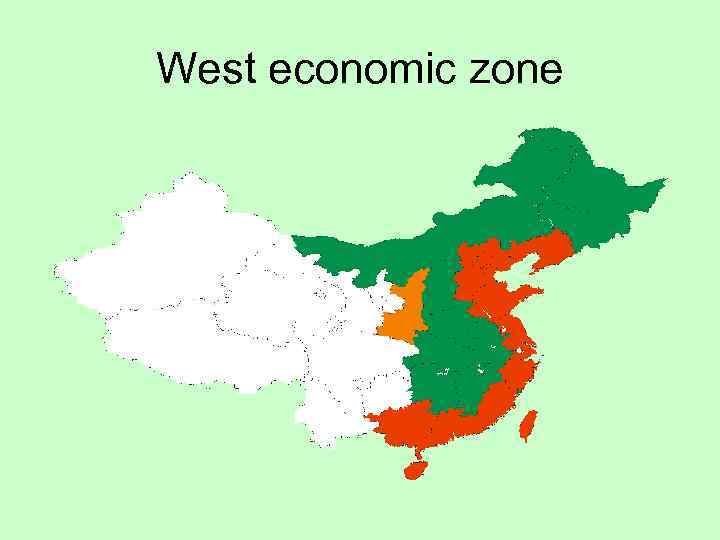 West economic zone
West economic zone
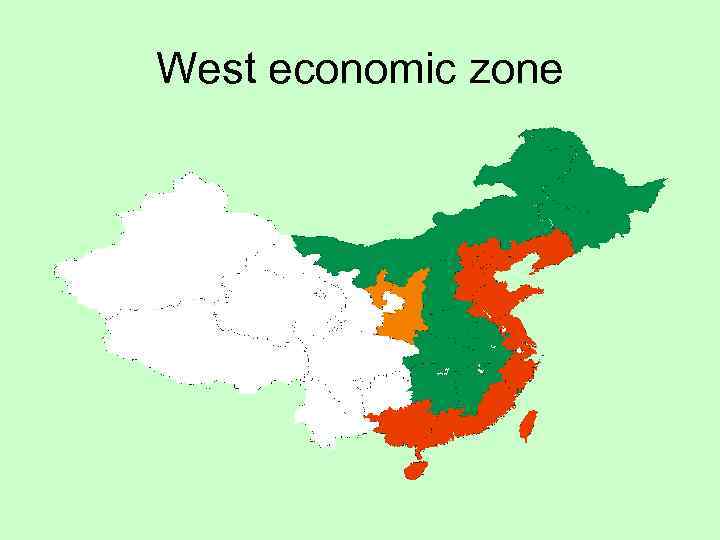 West economic zone
West economic zone
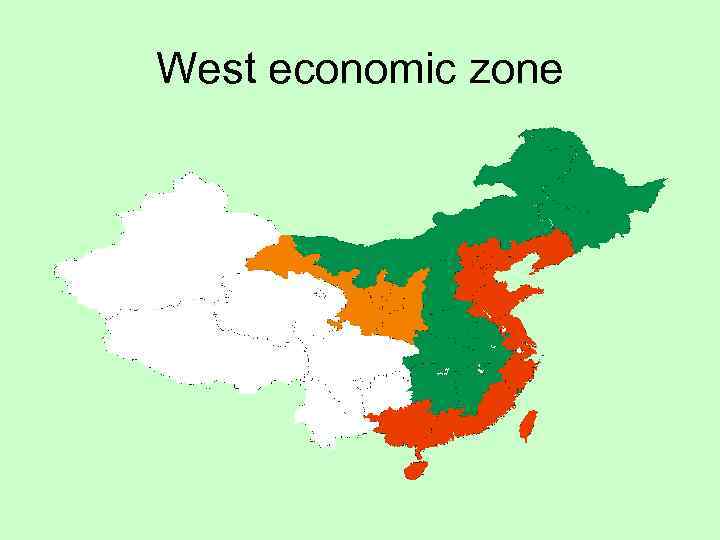 West economic zone
West economic zone
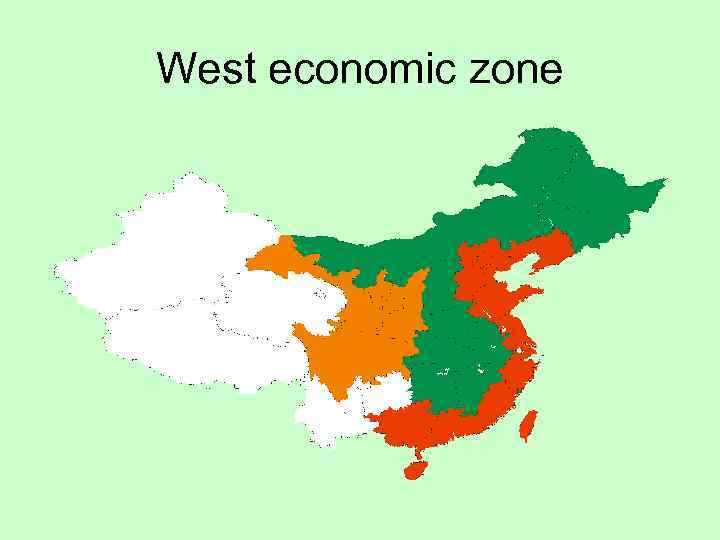 West economic zone
West economic zone
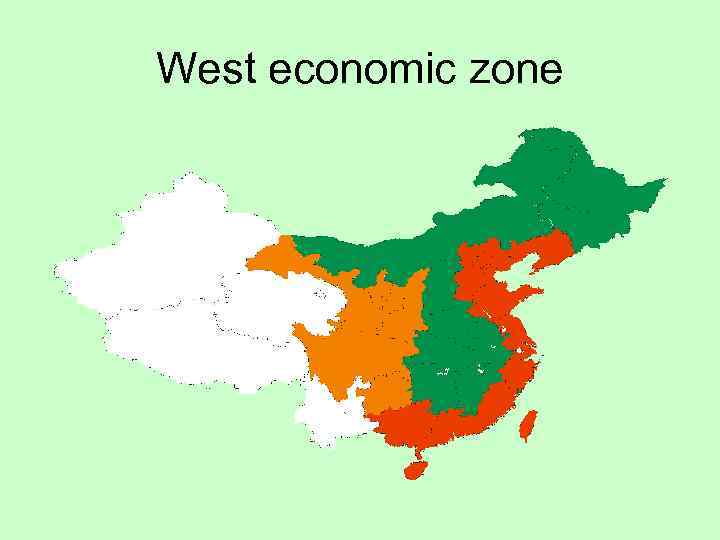 West economic zone
West economic zone
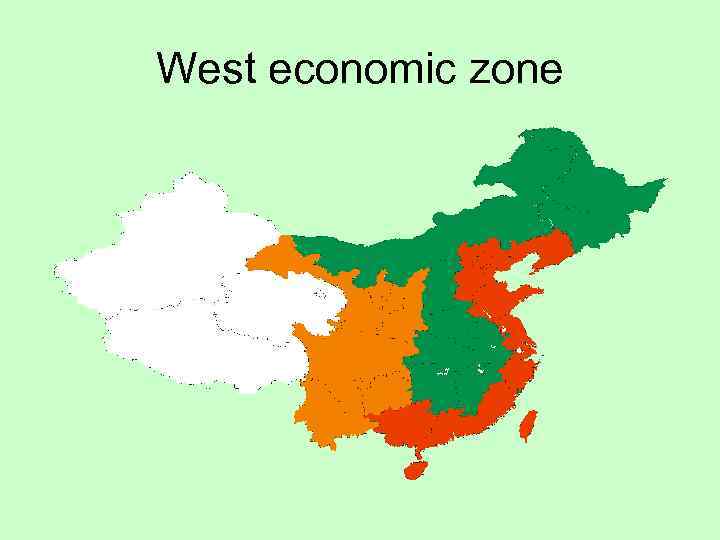 West economic zone
West economic zone
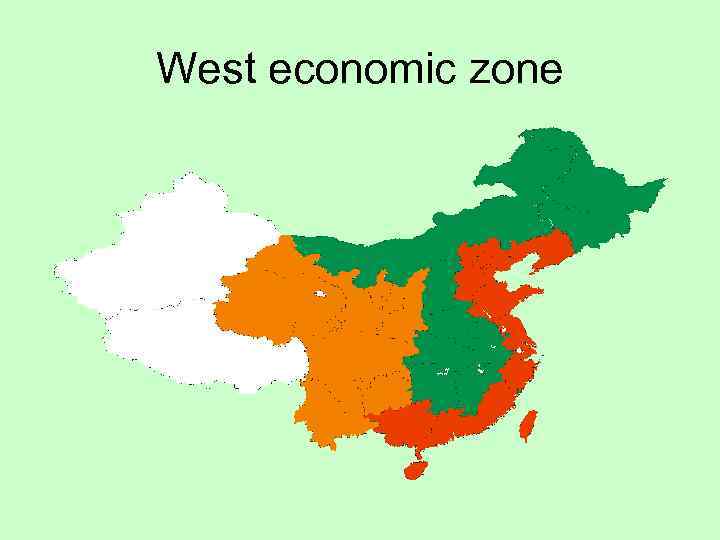 West economic zone
West economic zone
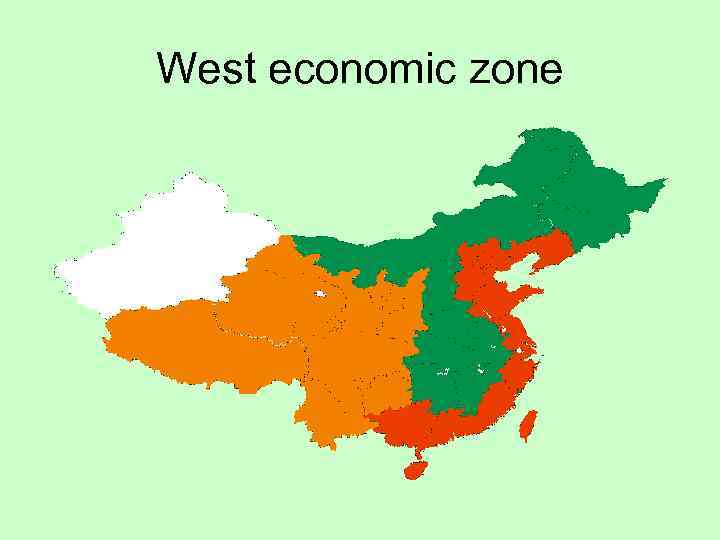 West economic zone
West economic zone
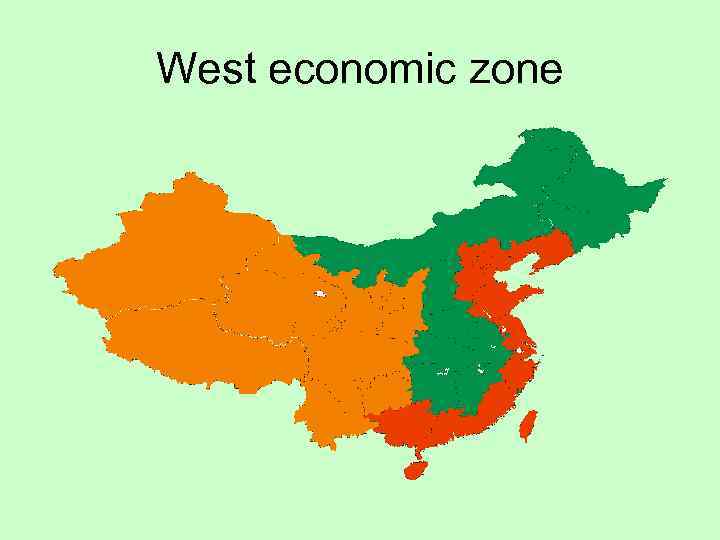 West economic zone
West economic zone
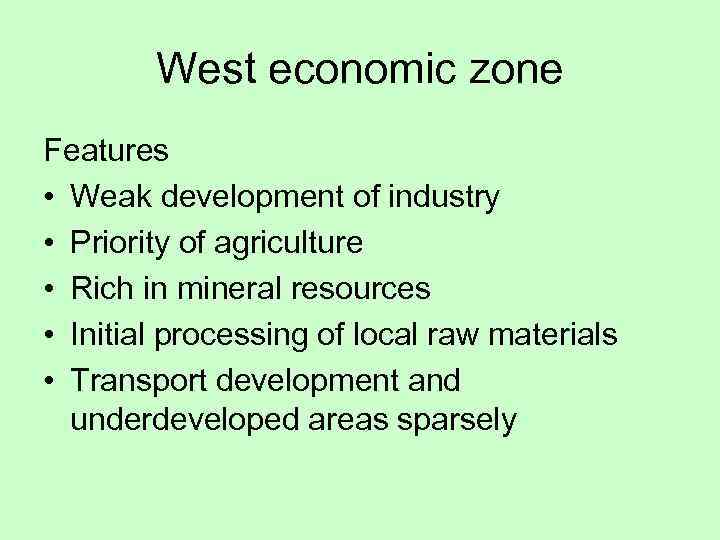 West economic zone Features • Weak development of industry • Priority of agriculture • Rich in mineral resources • Initial processing of local raw materials • Transport development and underdeveloped areas sparsely
West economic zone Features • Weak development of industry • Priority of agriculture • Rich in mineral resources • Initial processing of local raw materials • Transport development and underdeveloped areas sparsely
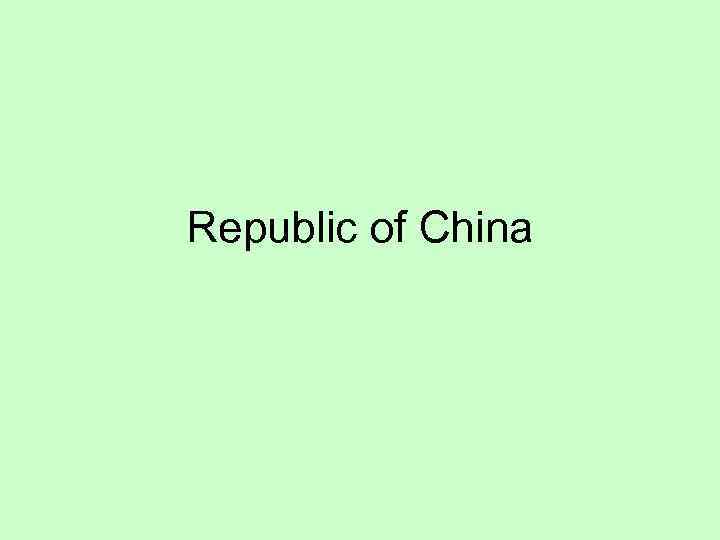 Republic of China
Republic of China
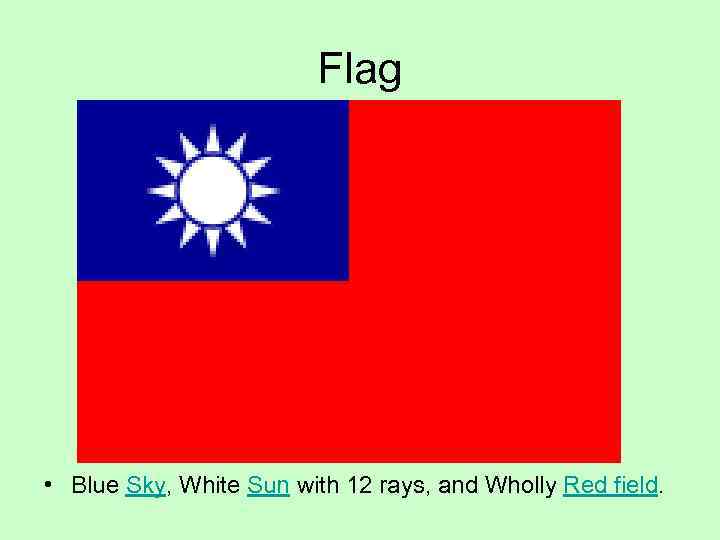 Flag • Blue Sky, White Sun with 12 rays, and Wholly Red field.
Flag • Blue Sky, White Sun with 12 rays, and Wholly Red field.
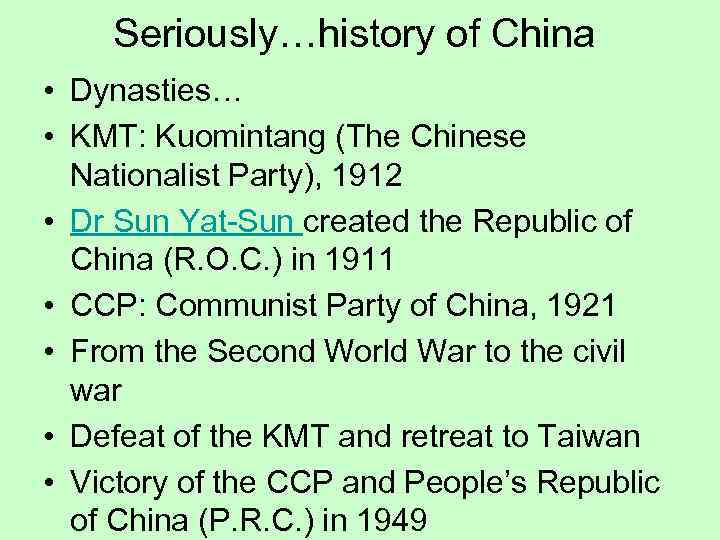 Seriously…history of China • Dynasties… • KMT: Kuomintang (The Chinese Nationalist Party), 1912 • Dr Sun Yat-Sun created the Republic of China (R. O. C. ) in 1911 • CCP: Communist Party of China, 1921 • From the Second World War to the civil war • Defeat of the KMT and retreat to Taiwan • Victory of the CCP and People’s Republic of China (P. R. C. ) in 1949
Seriously…history of China • Dynasties… • KMT: Kuomintang (The Chinese Nationalist Party), 1912 • Dr Sun Yat-Sun created the Republic of China (R. O. C. ) in 1911 • CCP: Communist Party of China, 1921 • From the Second World War to the civil war • Defeat of the KMT and retreat to Taiwan • Victory of the CCP and People’s Republic of China (P. R. C. ) in 1949
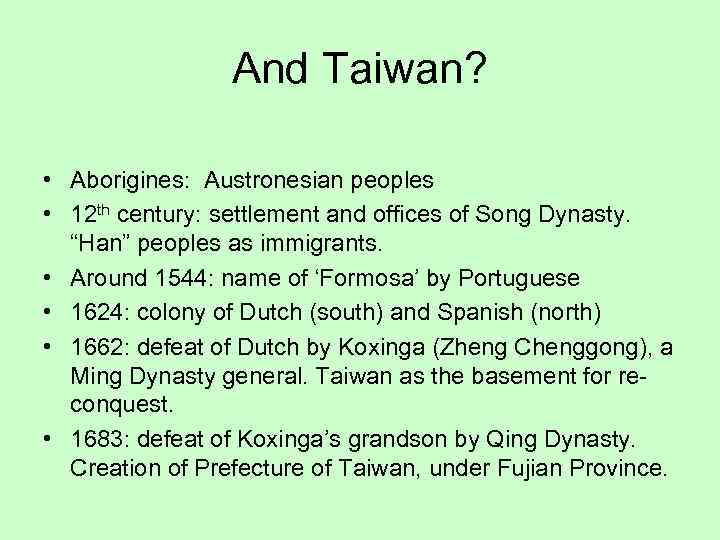 And Taiwan? • Aborigines: Austronesian peoples • 12 th century: settlement and offices of Song Dynasty. “Han” peoples as immigrants. • Around 1544: name of ‘Formosa’ by Portuguese • 1624: colony of Dutch (south) and Spanish (north) • 1662: defeat of Dutch by Koxinga (Zheng Chenggong), a Ming Dynasty general. Taiwan as the basement for reconquest. • 1683: defeat of Koxinga’s grandson by Qing Dynasty. Creation of Prefecture of Taiwan, under Fujian Province.
And Taiwan? • Aborigines: Austronesian peoples • 12 th century: settlement and offices of Song Dynasty. “Han” peoples as immigrants. • Around 1544: name of ‘Formosa’ by Portuguese • 1624: colony of Dutch (south) and Spanish (north) • 1662: defeat of Dutch by Koxinga (Zheng Chenggong), a Ming Dynasty general. Taiwan as the basement for reconquest. • 1683: defeat of Koxinga’s grandson by Qing Dynasty. Creation of Prefecture of Taiwan, under Fujian Province.
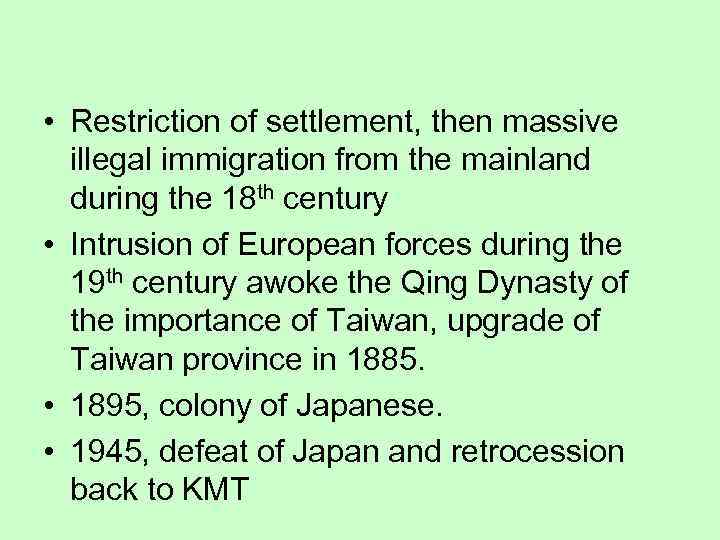 • Restriction of settlement, then massive illegal immigration from the mainland during the 18 th century • Intrusion of European forces during the 19 th century awoke the Qing Dynasty of the importance of Taiwan, upgrade of Taiwan province in 1885. • 1895, colony of Japanese. • 1945, defeat of Japan and retrocession back to KMT
• Restriction of settlement, then massive illegal immigration from the mainland during the 18 th century • Intrusion of European forces during the 19 th century awoke the Qing Dynasty of the importance of Taiwan, upgrade of Taiwan province in 1885. • 1895, colony of Japanese. • 1945, defeat of Japan and retrocession back to KMT
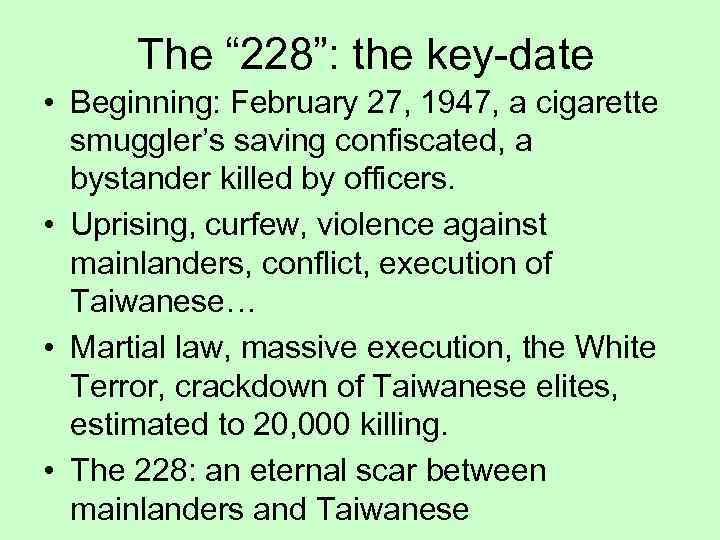 The “ 228”: the key-date • Beginning: February 27, 1947, a cigarette smuggler’s saving confiscated, a bystander killed by officers. • Uprising, curfew, violence against mainlanders, conflict, execution of Taiwanese… • Martial law, massive execution, the White Terror, crackdown of Taiwanese elites, estimated to 20, 000 killing. • The 228: an eternal scar between mainlanders and Taiwanese
The “ 228”: the key-date • Beginning: February 27, 1947, a cigarette smuggler’s saving confiscated, a bystander killed by officers. • Uprising, curfew, violence against mainlanders, conflict, execution of Taiwanese… • Martial law, massive execution, the White Terror, crackdown of Taiwanese elites, estimated to 20, 000 killing. • The 228: an eternal scar between mainlanders and Taiwanese
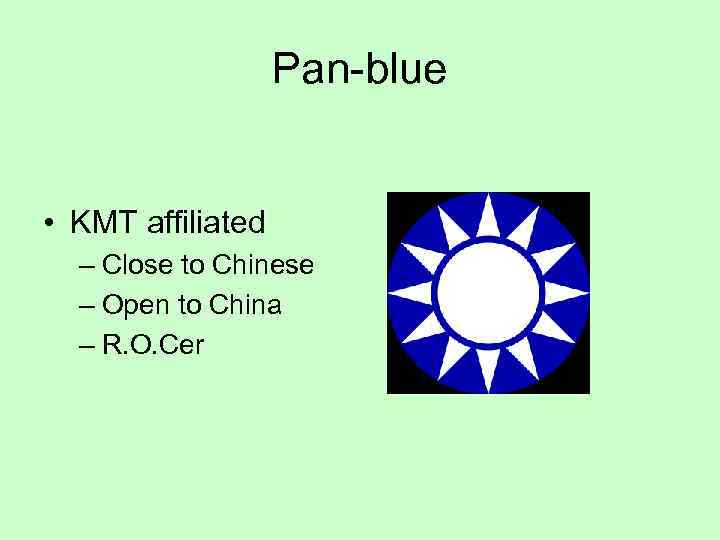 Pan-blue • KMT affiliated – Close to Chinese – Open to China – R. O. Cer
Pan-blue • KMT affiliated – Close to Chinese – Open to China – R. O. Cer
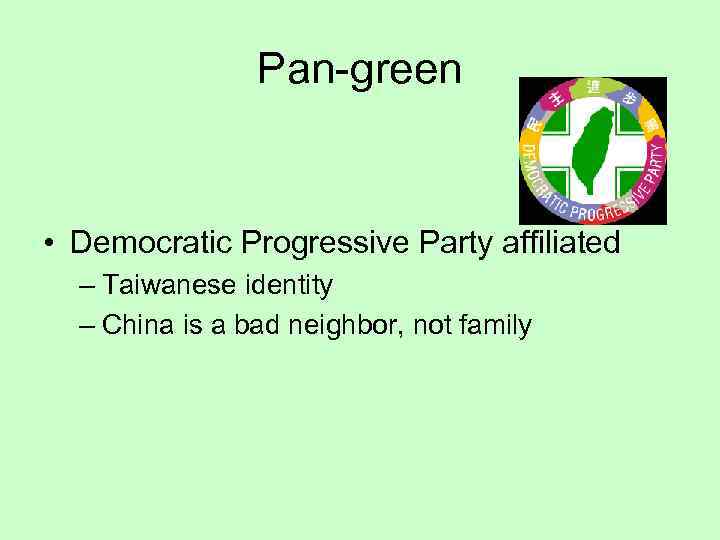 Pan-green • Democratic Progressive Party affiliated – Taiwanese identity – China is a bad neighbor, not family
Pan-green • Democratic Progressive Party affiliated – Taiwanese identity – China is a bad neighbor, not family
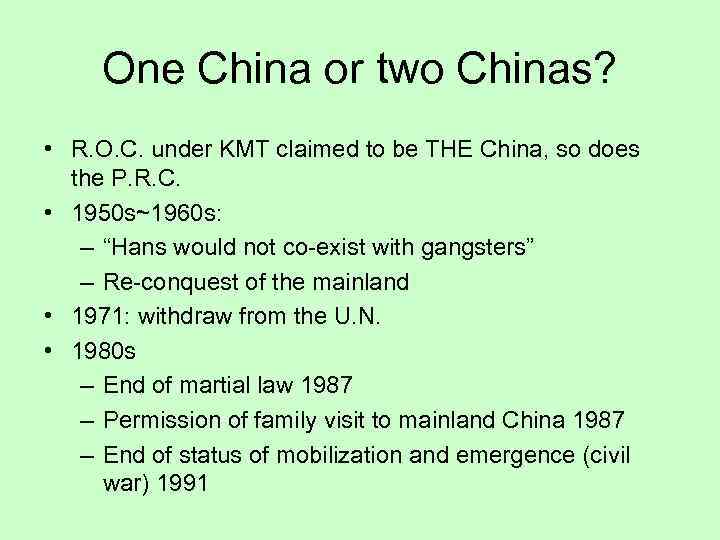 One China or two Chinas? • R. O. C. under KMT claimed to be THE China, so does the P. R. C. • 1950 s~1960 s: – “Hans would not co-exist with gangsters” – Re-conquest of the mainland • 1971: withdraw from the U. N. • 1980 s – End of martial law 1987 – Permission of family visit to mainland China 1987 – End of status of mobilization and emergence (civil war) 1991
One China or two Chinas? • R. O. C. under KMT claimed to be THE China, so does the P. R. C. • 1950 s~1960 s: – “Hans would not co-exist with gangsters” – Re-conquest of the mainland • 1971: withdraw from the U. N. • 1980 s – End of martial law 1987 – Permission of family visit to mainland China 1987 – End of status of mobilization and emergence (civil war) 1991
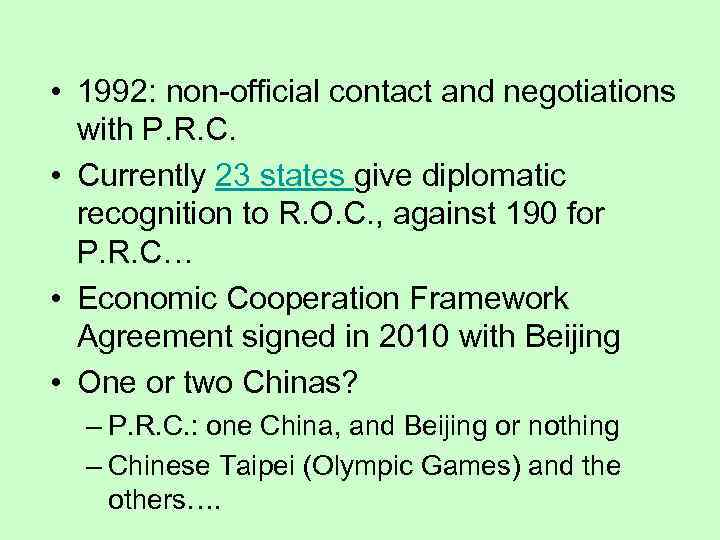 • 1992: non-official contact and negotiations with P. R. C. • Currently 23 states give diplomatic recognition to R. O. C. , against 190 for P. R. C… • Economic Cooperation Framework Agreement signed in 2010 with Beijing • One or two Chinas? – P. R. C. : one China, and Beijing or nothing – Chinese Taipei (Olympic Games) and the others….
• 1992: non-official contact and negotiations with P. R. C. • Currently 23 states give diplomatic recognition to R. O. C. , against 190 for P. R. C… • Economic Cooperation Framework Agreement signed in 2010 with Beijing • One or two Chinas? – P. R. C. : one China, and Beijing or nothing – Chinese Taipei (Olympic Games) and the others….
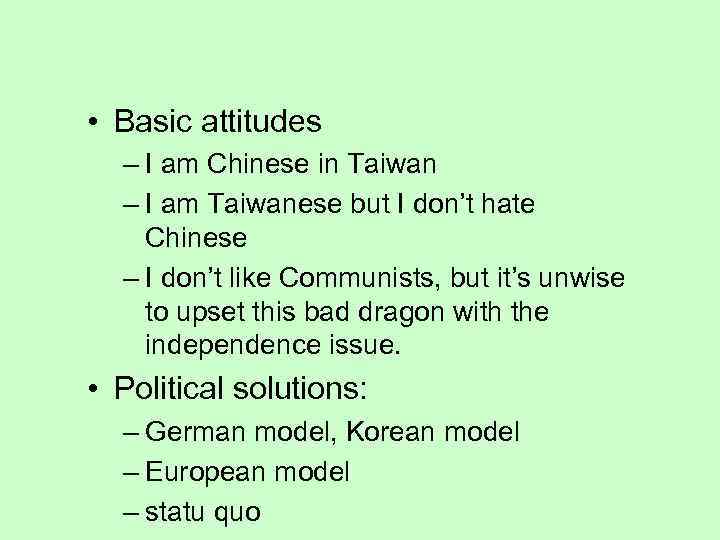 • Basic attitudes – I am Chinese in Taiwan – I am Taiwanese but I don’t hate Chinese – I don’t like Communists, but it’s unwise to upset this bad dragon with the independence issue. • Political solutions: – German model, Korean model – European model – statu quo
• Basic attitudes – I am Chinese in Taiwan – I am Taiwanese but I don’t hate Chinese – I don’t like Communists, but it’s unwise to upset this bad dragon with the independence issue. • Political solutions: – German model, Korean model – European model – statu quo
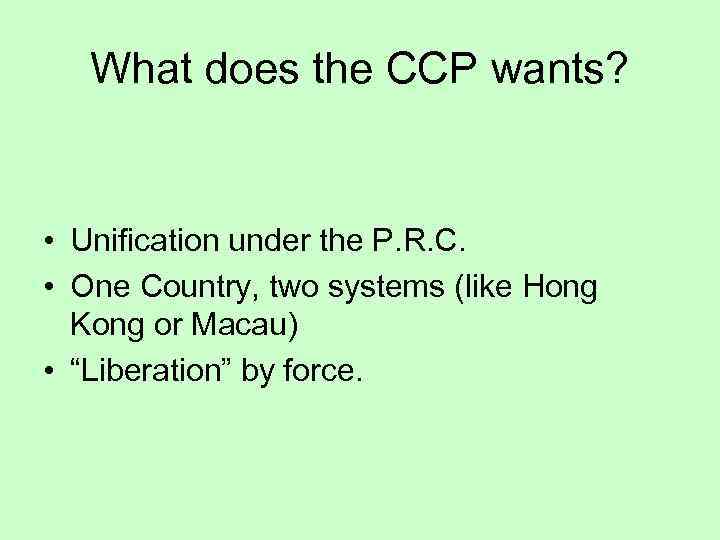 What does the CCP wants? • Unification under the P. R. C. • One Country, two systems (like Hong Kong or Macau) • “Liberation” by force.
What does the CCP wants? • Unification under the P. R. C. • One Country, two systems (like Hong Kong or Macau) • “Liberation” by force.
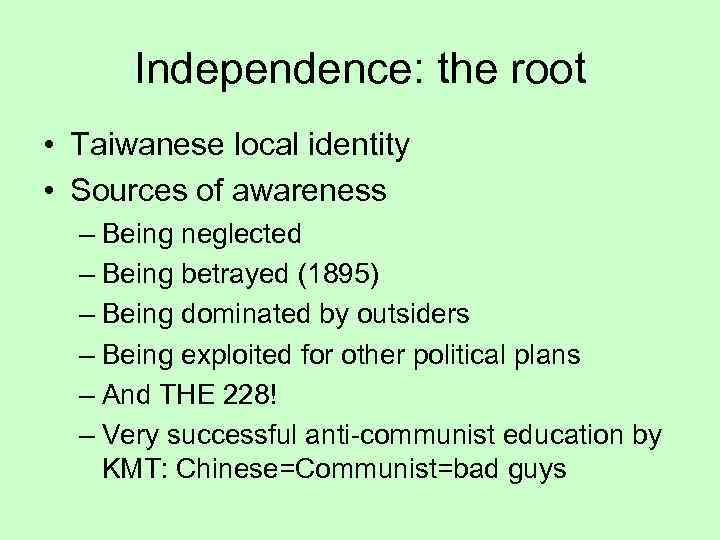 Independence: the root • Taiwanese local identity • Sources of awareness – Being neglected – Being betrayed (1895) – Being dominated by outsiders – Being exploited for other political plans – And THE 228! – Very successful anti-communist education by KMT: Chinese=Communist=bad guys
Independence: the root • Taiwanese local identity • Sources of awareness – Being neglected – Being betrayed (1895) – Being dominated by outsiders – Being exploited for other political plans – And THE 228! – Very successful anti-communist education by KMT: Chinese=Communist=bad guys
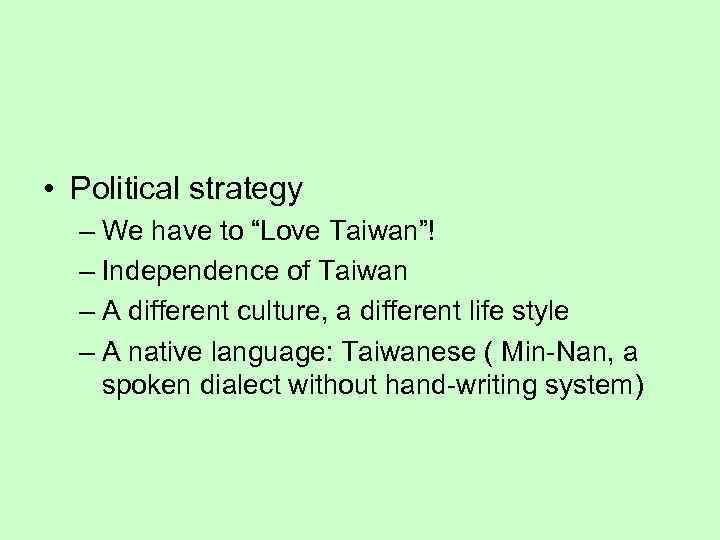 • Political strategy – We have to “Love Taiwan”! – Independence of Taiwan – A different culture, a different life style – A native language: Taiwanese ( Min-Nan, a spoken dialect without hand-writing system)
• Political strategy – We have to “Love Taiwan”! – Independence of Taiwan – A different culture, a different life style – A native language: Taiwanese ( Min-Nan, a spoken dialect without hand-writing system)
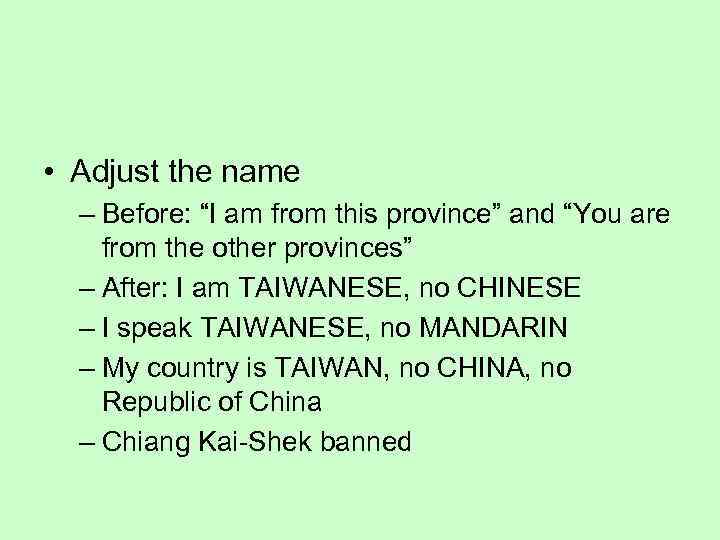 • Adjust the name – Before: “I am from this province” and “You are from the other provinces” – After: I am TAIWANESE, no CHINESE – I speak TAIWANESE, no MANDARIN – My country is TAIWAN, no CHINA, no Republic of China – Chiang Kai-Shek banned
• Adjust the name – Before: “I am from this province” and “You are from the other provinces” – After: I am TAIWANESE, no CHINESE – I speak TAIWANESE, no MANDARIN – My country is TAIWAN, no CHINA, no Republic of China – Chiang Kai-Shek banned
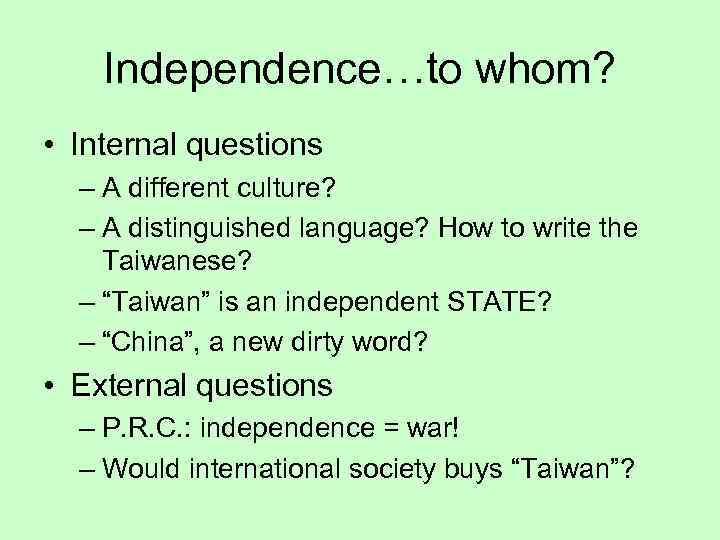 Independence…to whom? • Internal questions – A different culture? – A distinguished language? How to write the Taiwanese? – “Taiwan” is an independent STATE? – “China”, a new dirty word? • External questions – P. R. C. : independence = war! – Would international society buys “Taiwan”?
Independence…to whom? • Internal questions – A different culture? – A distinguished language? How to write the Taiwanese? – “Taiwan” is an independent STATE? – “China”, a new dirty word? • External questions – P. R. C. : independence = war! – Would international society buys “Taiwan”?
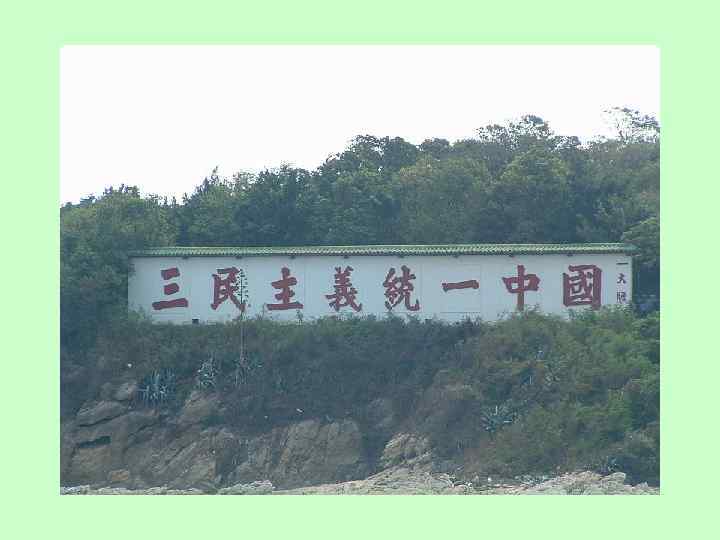
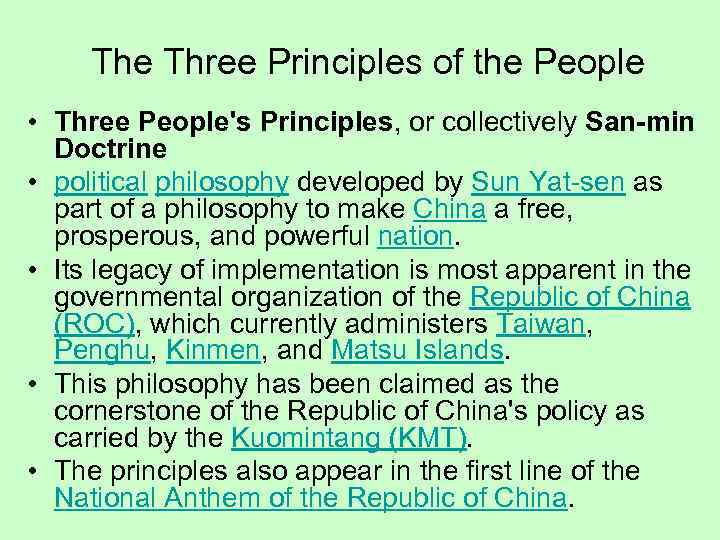 The Three Principles of the People • Three People's Principles, or collectively San-min Doctrine • political philosophy developed by Sun Yat-sen as part of a philosophy to make China a free, prosperous, and powerful nation. • Its legacy of implementation is most apparent in the governmental organization of the Republic of China (ROC), which currently administers Taiwan, Penghu, Kinmen, and Matsu Islands. • This philosophy has been claimed as the cornerstone of the Republic of China's policy as carried by the Kuomintang (KMT). • The principles also appear in the first line of the National Anthem of the Republic of China.
The Three Principles of the People • Three People's Principles, or collectively San-min Doctrine • political philosophy developed by Sun Yat-sen as part of a philosophy to make China a free, prosperous, and powerful nation. • Its legacy of implementation is most apparent in the governmental organization of the Republic of China (ROC), which currently administers Taiwan, Penghu, Kinmen, and Matsu Islands. • This philosophy has been claimed as the cornerstone of the Republic of China's policy as carried by the Kuomintang (KMT). • The principles also appear in the first line of the National Anthem of the Republic of China.
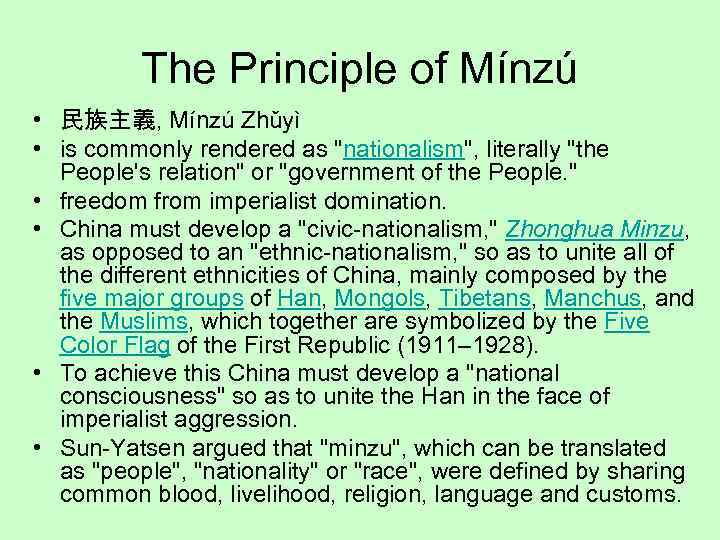 The Principle of Mínzú • 民族主義, Mínzú Zhǔyì • is commonly rendered as "nationalism", literally "the People's relation" or "government of the People. " • freedom from imperialist domination. • China must develop a "civic-nationalism, " Zhonghua Minzu, as opposed to an "ethnic-nationalism, " so as to unite all of the different ethnicities of China, mainly composed by the five major groups of Han, Mongols, Tibetans, Manchus, and the Muslims, which together are symbolized by the Five Color Flag of the First Republic (1911– 1928). • To achieve this China must develop a "national consciousness" so as to unite the Han in the face of imperialist aggression. • Sun-Yatsen argued that "minzu", which can be translated as "people", "nationality" or "race", were defined by sharing common blood, livelihood, religion, language and customs.
The Principle of Mínzú • 民族主義, Mínzú Zhǔyì • is commonly rendered as "nationalism", literally "the People's relation" or "government of the People. " • freedom from imperialist domination. • China must develop a "civic-nationalism, " Zhonghua Minzu, as opposed to an "ethnic-nationalism, " so as to unite all of the different ethnicities of China, mainly composed by the five major groups of Han, Mongols, Tibetans, Manchus, and the Muslims, which together are symbolized by the Five Color Flag of the First Republic (1911– 1928). • To achieve this China must develop a "national consciousness" so as to unite the Han in the face of imperialist aggression. • Sun-Yatsen argued that "minzu", which can be translated as "people", "nationality" or "race", were defined by sharing common blood, livelihood, religion, language and customs.
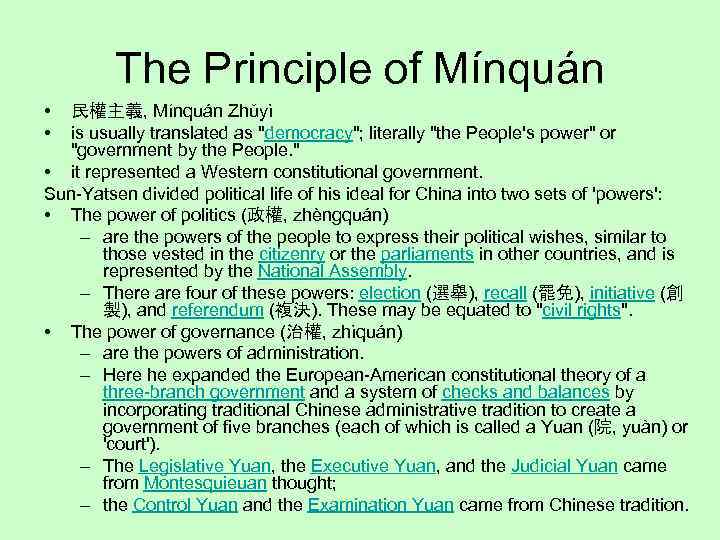 The Principle of Mínquán • • 民權主義, Mínquán Zhǔyì is usually translated as "democracy"; literally "the People's power" or "government by the People. " • it represented a Western constitutional government. Sun-Yatsen divided political life of his ideal for China into two sets of 'powers': • The power of politics (政權, zhèngquán) – are the powers of the people to express their political wishes, similar to those vested in the citizenry or the parliaments in other countries, and is represented by the National Assembly. – There are four of these powers: election (選舉), recall (罷免), initiative (創 製), and referendum (複決). These may be equated to "civil rights". • The power of governance (治權, zhìquán) – are the powers of administration. – Here he expanded the European-American constitutional theory of a three-branch government and a system of checks and balances by incorporating traditional Chinese administrative tradition to create a government of five branches (each of which is called a Yuan (院, yuàn) or 'court'). – The Legislative Yuan, the Executive Yuan, and the Judicial Yuan came from Montesquieuan thought; – the Control Yuan and the Examination Yuan came from Chinese tradition.
The Principle of Mínquán • • 民權主義, Mínquán Zhǔyì is usually translated as "democracy"; literally "the People's power" or "government by the People. " • it represented a Western constitutional government. Sun-Yatsen divided political life of his ideal for China into two sets of 'powers': • The power of politics (政權, zhèngquán) – are the powers of the people to express their political wishes, similar to those vested in the citizenry or the parliaments in other countries, and is represented by the National Assembly. – There are four of these powers: election (選舉), recall (罷免), initiative (創 製), and referendum (複決). These may be equated to "civil rights". • The power of governance (治權, zhìquán) – are the powers of administration. – Here he expanded the European-American constitutional theory of a three-branch government and a system of checks and balances by incorporating traditional Chinese administrative tradition to create a government of five branches (each of which is called a Yuan (院, yuàn) or 'court'). – The Legislative Yuan, the Executive Yuan, and the Judicial Yuan came from Montesquieuan thought; – the Control Yuan and the Examination Yuan came from Chinese tradition.
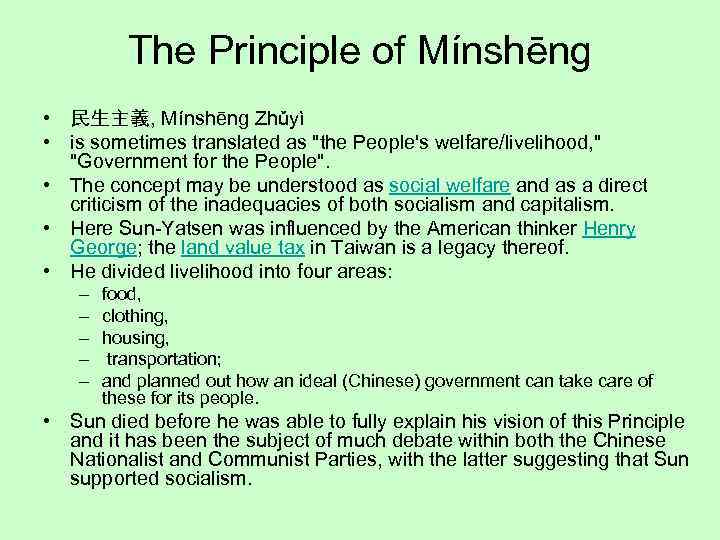 The Principle of Mínshēng • 民生主義, Mínshēng Zhǔyì • is sometimes translated as "the People's welfare/livelihood, " "Government for the People". • The concept may be understood as social welfare and as a direct criticism of the inadequacies of both socialism and capitalism. • Here Sun-Yatsen was influenced by the American thinker Henry George; the land value tax in Taiwan is a legacy thereof. • He divided livelihood into four areas: – – – food, clothing, housing, transportation; and planned out how an ideal (Chinese) government can take care of these for its people. • Sun died before he was able to fully explain his vision of this Principle and it has been the subject of much debate within both the Chinese Nationalist and Communist Parties, with the latter suggesting that Sun supported socialism.
The Principle of Mínshēng • 民生主義, Mínshēng Zhǔyì • is sometimes translated as "the People's welfare/livelihood, " "Government for the People". • The concept may be understood as social welfare and as a direct criticism of the inadequacies of both socialism and capitalism. • Here Sun-Yatsen was influenced by the American thinker Henry George; the land value tax in Taiwan is a legacy thereof. • He divided livelihood into four areas: – – – food, clothing, housing, transportation; and planned out how an ideal (Chinese) government can take care of these for its people. • Sun died before he was able to fully explain his vision of this Principle and it has been the subject of much debate within both the Chinese Nationalist and Communist Parties, with the latter suggesting that Sun supported socialism.
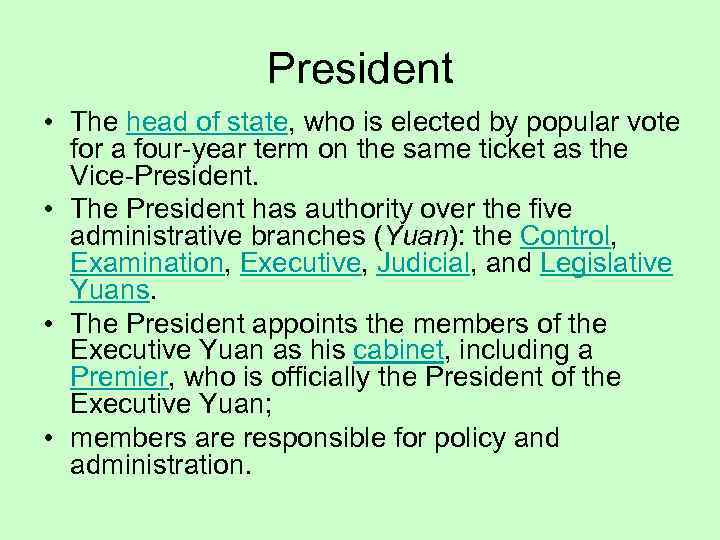 President • The head of state, who is elected by popular vote for a four-year term on the same ticket as the Vice-President. • The President has authority over the five administrative branches (Yuan): the Control, Examination, Executive, Judicial, and Legislative Yuans. • The President appoints the members of the Executive Yuan as his cabinet, including a Premier, who is officially the President of the Executive Yuan; • members are responsible for policy and administration.
President • The head of state, who is elected by popular vote for a four-year term on the same ticket as the Vice-President. • The President has authority over the five administrative branches (Yuan): the Control, Examination, Executive, Judicial, and Legislative Yuans. • The President appoints the members of the Executive Yuan as his cabinet, including a Premier, who is officially the President of the Executive Yuan; • members are responsible for policy and administration.
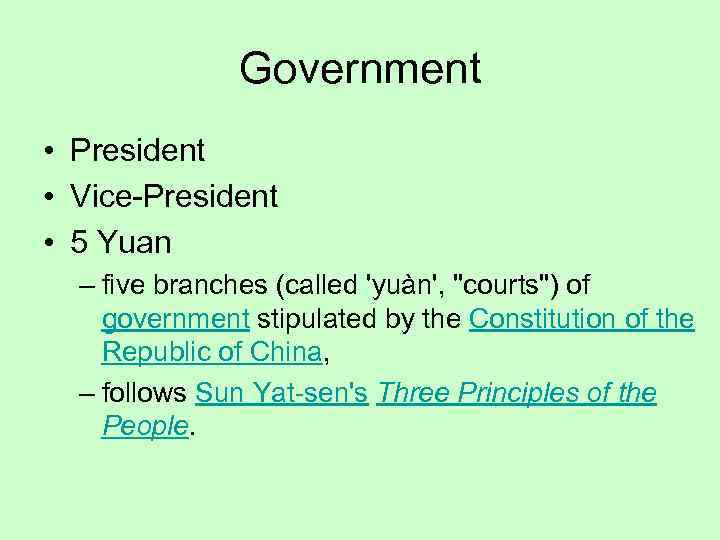 Government • President • Vice-President • 5 Yuan – five branches (called 'yuàn', "courts") of government stipulated by the Constitution of the Republic of China, – follows Sun Yat-sen's Three Principles of the People.
Government • President • Vice-President • 5 Yuan – five branches (called 'yuàn', "courts") of government stipulated by the Constitution of the Republic of China, – follows Sun Yat-sen's Three Principles of the People.
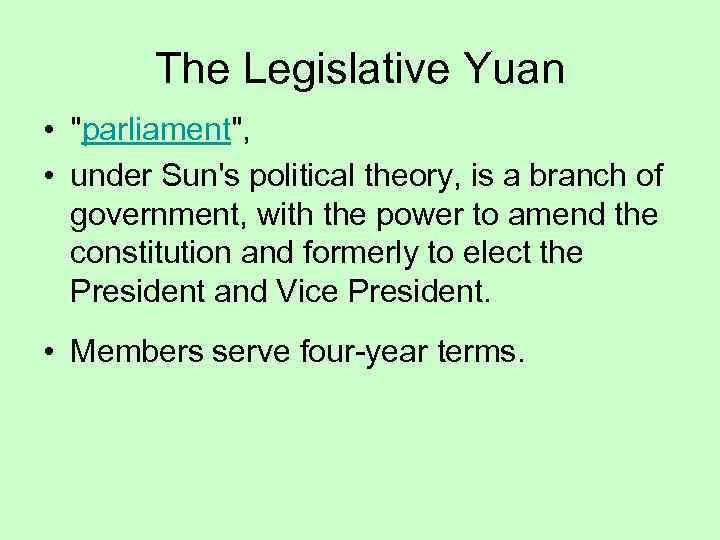 The Legislative Yuan • "parliament", • under Sun's political theory, is a branch of government, with the power to amend the constitution and formerly to elect the President and Vice President. • Members serve four-year terms.
The Legislative Yuan • "parliament", • under Sun's political theory, is a branch of government, with the power to amend the constitution and formerly to elect the President and Vice President. • Members serve four-year terms.
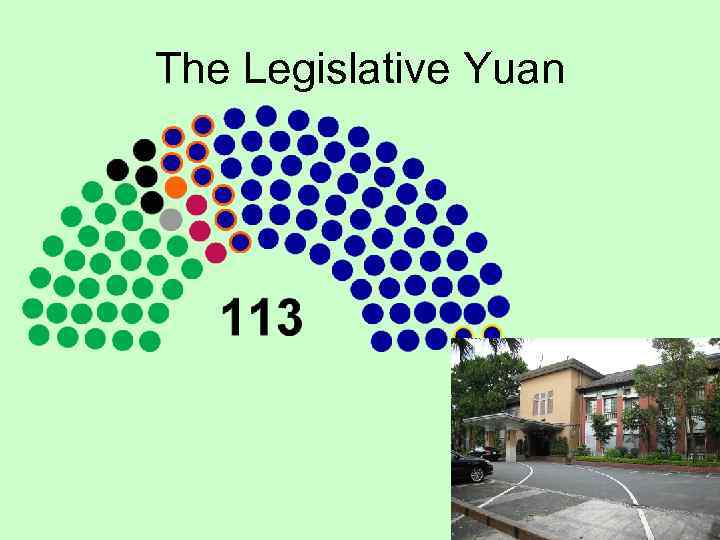 The Legislative Yuan
The Legislative Yuan
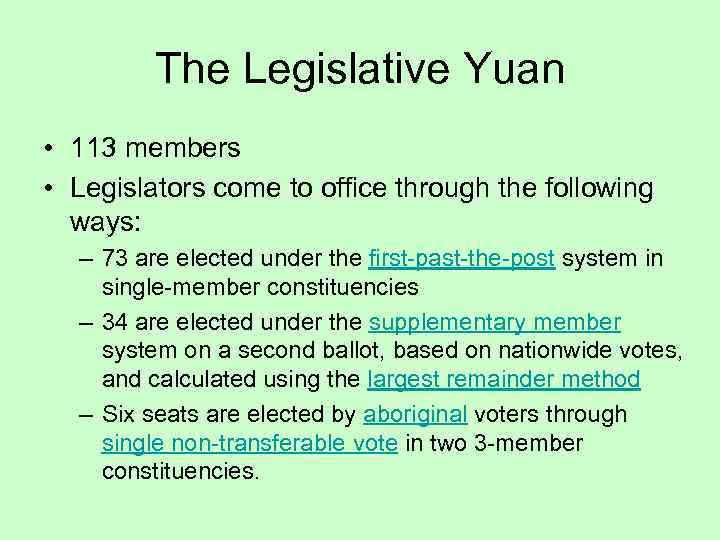 The Legislative Yuan • 113 members • Legislators come to office through the following ways: – 73 are elected under the first-past-the-post system in single-member constituencies – 34 are elected under the supplementary member system on a second ballot, based on nationwide votes, and calculated using the largest remainder method – Six seats are elected by aboriginal voters through single non-transferable vote in two 3 -member constituencies.
The Legislative Yuan • 113 members • Legislators come to office through the following ways: – 73 are elected under the first-past-the-post system in single-member constituencies – 34 are elected under the supplementary member system on a second ballot, based on nationwide votes, and calculated using the largest remainder method – Six seats are elected by aboriginal voters through single non-transferable vote in two 3 -member constituencies.
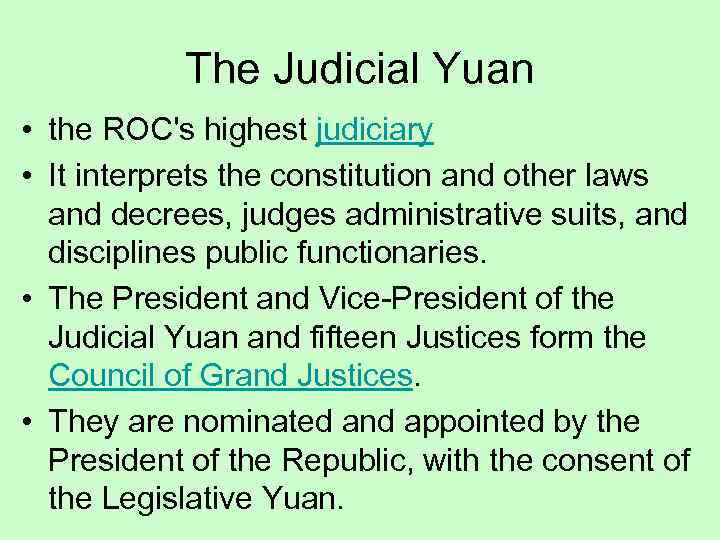 The Judicial Yuan • the ROC's highest judiciary • It interprets the constitution and other laws and decrees, judges administrative suits, and disciplines public functionaries. • The President and Vice-President of the Judicial Yuan and fifteen Justices form the Council of Grand Justices. • They are nominated and appointed by the President of the Republic, with the consent of the Legislative Yuan.
The Judicial Yuan • the ROC's highest judiciary • It interprets the constitution and other laws and decrees, judges administrative suits, and disciplines public functionaries. • The President and Vice-President of the Judicial Yuan and fifteen Justices form the Council of Grand Justices. • They are nominated and appointed by the President of the Republic, with the consent of the Legislative Yuan.
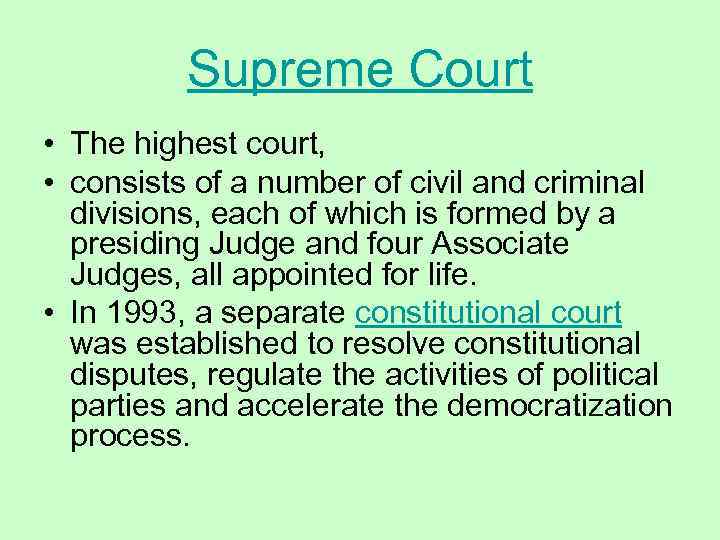 Supreme Court • The highest court, • consists of a number of civil and criminal divisions, each of which is formed by a presiding Judge and four Associate Judges, all appointed for life. • In 1993, a separate constitutional court was established to resolve constitutional disputes, regulate the activities of political parties and accelerate the democratization process.
Supreme Court • The highest court, • consists of a number of civil and criminal divisions, each of which is formed by a presiding Judge and four Associate Judges, all appointed for life. • In 1993, a separate constitutional court was established to resolve constitutional disputes, regulate the activities of political parties and accelerate the democratization process.
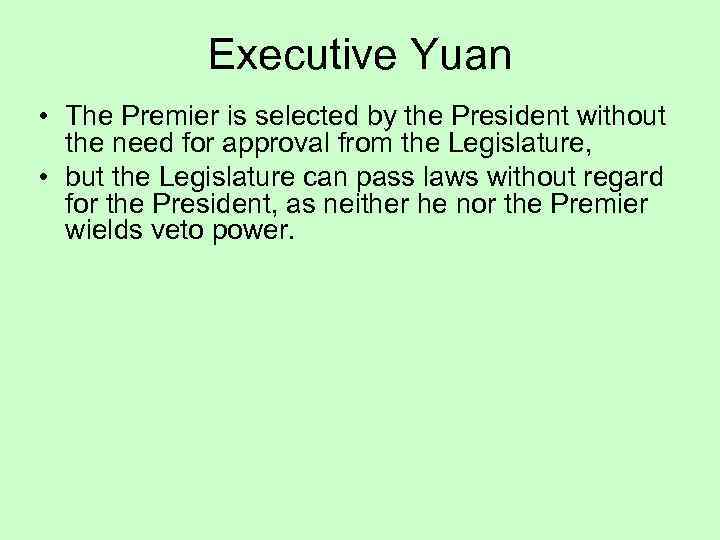 Executive Yuan • The Premier is selected by the President without the need for approval from the Legislature, • but the Legislature can pass laws without regard for the President, as neither he nor the Premier wields veto power.
Executive Yuan • The Premier is selected by the President without the need for approval from the Legislature, • but the Legislature can pass laws without regard for the President, as neither he nor the Premier wields veto power.
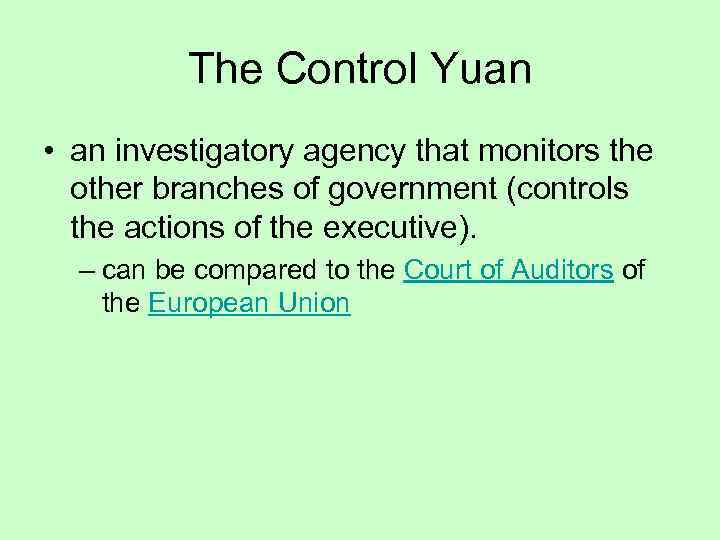 The Control Yuan • an investigatory agency that monitors the other branches of government (controls the actions of the executive). – can be compared to the Court of Auditors of the European Union
The Control Yuan • an investigatory agency that monitors the other branches of government (controls the actions of the executive). – can be compared to the Court of Auditors of the European Union
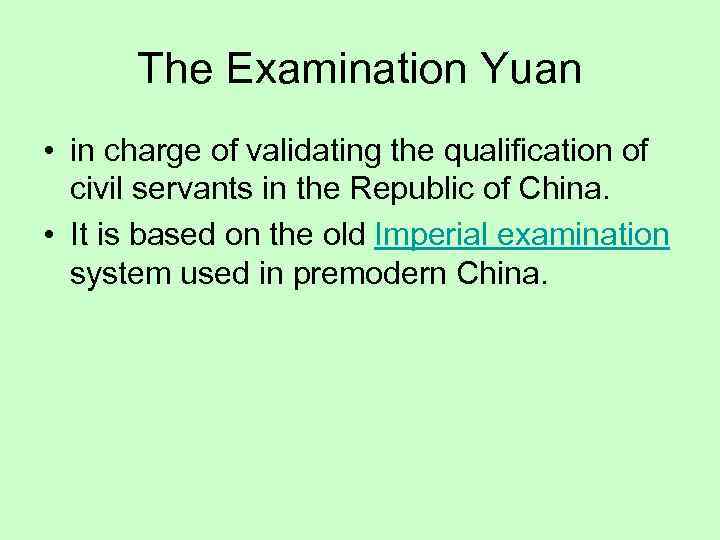 The Examination Yuan • in charge of validating the qualification of civil servants in the Republic of China. • It is based on the old Imperial examination system used in premodern China.
The Examination Yuan • in charge of validating the qualification of civil servants in the Republic of China. • It is based on the old Imperial examination system used in premodern China.


